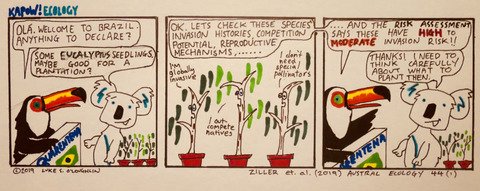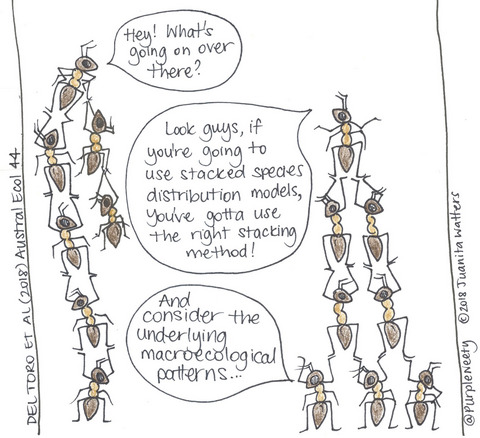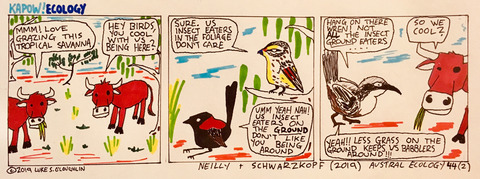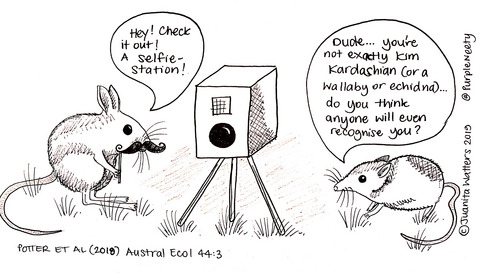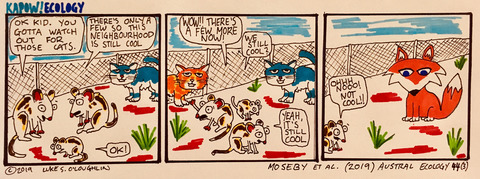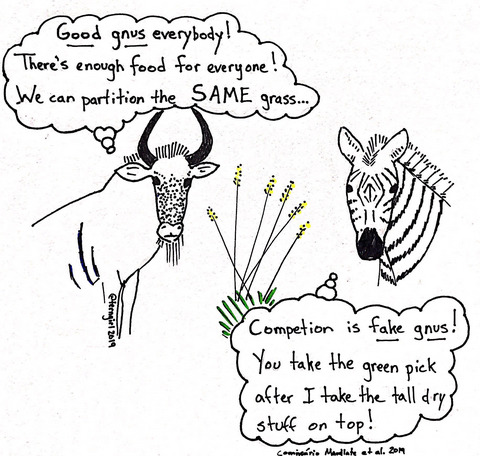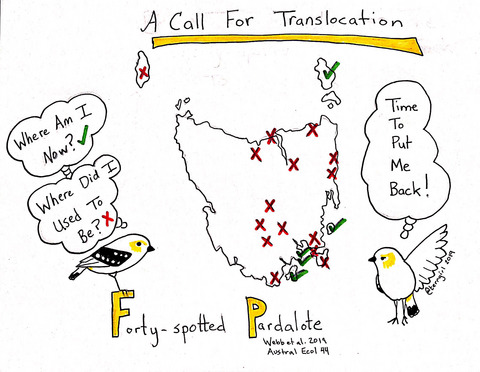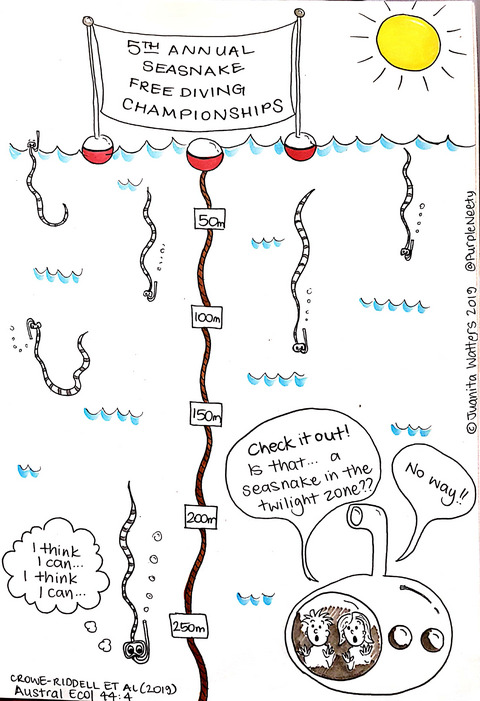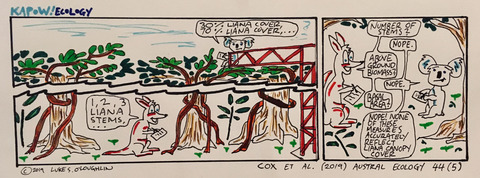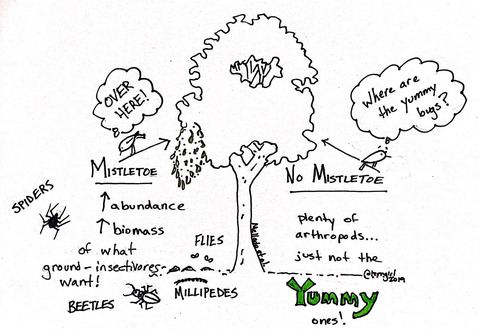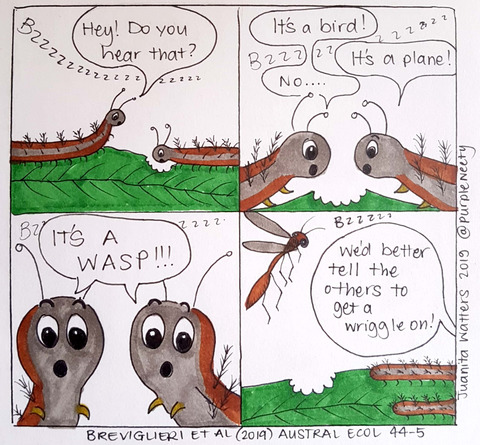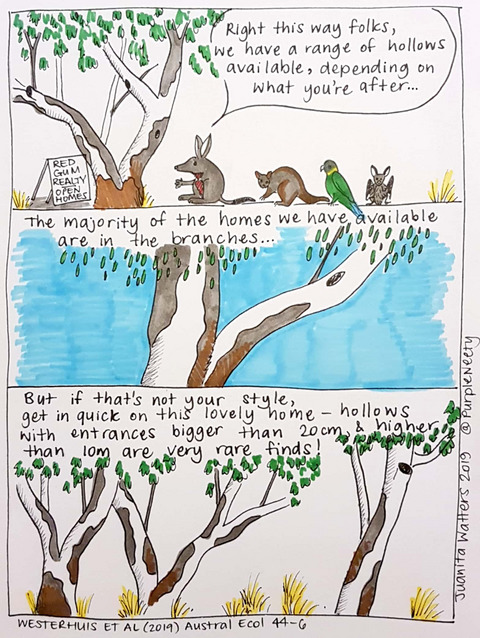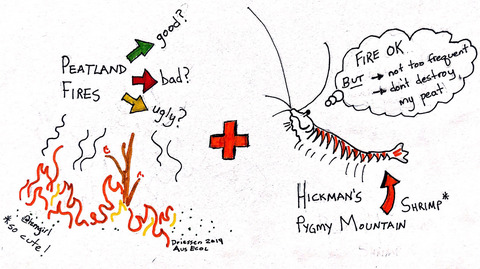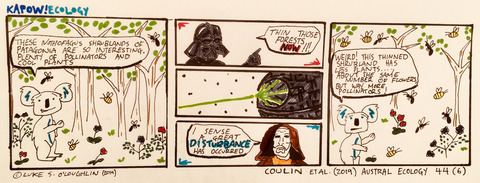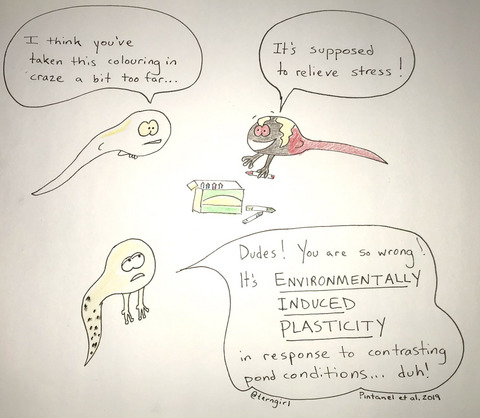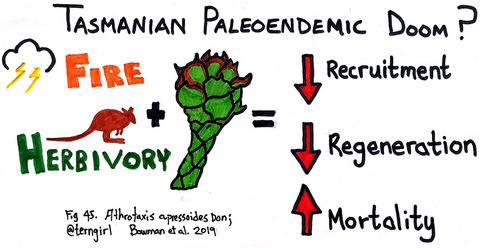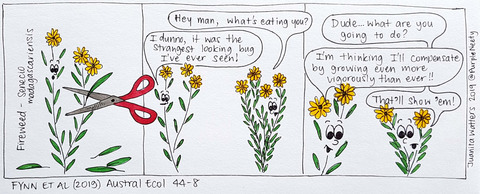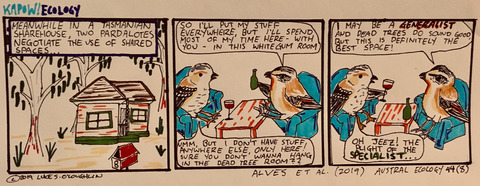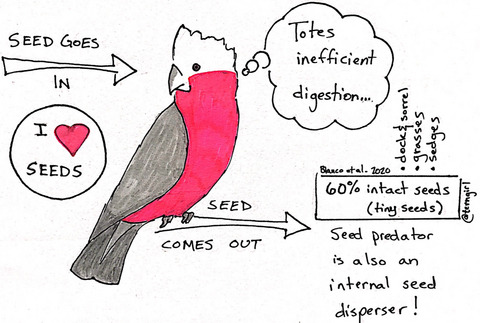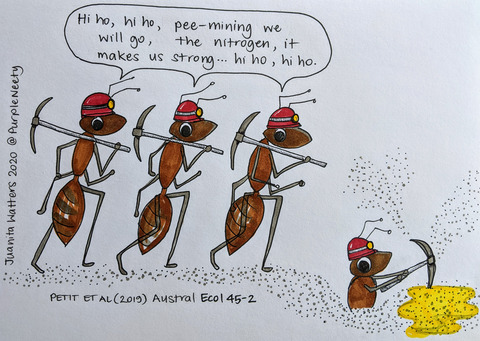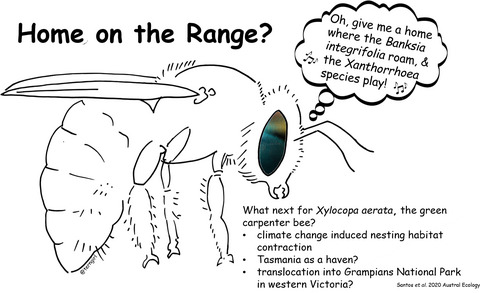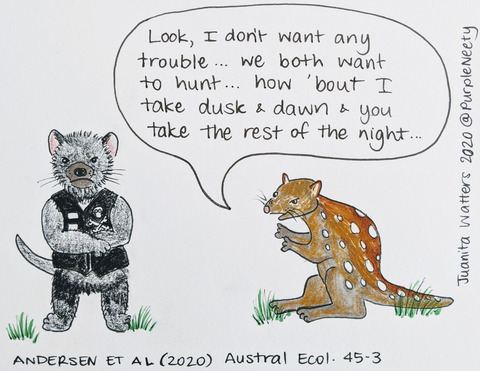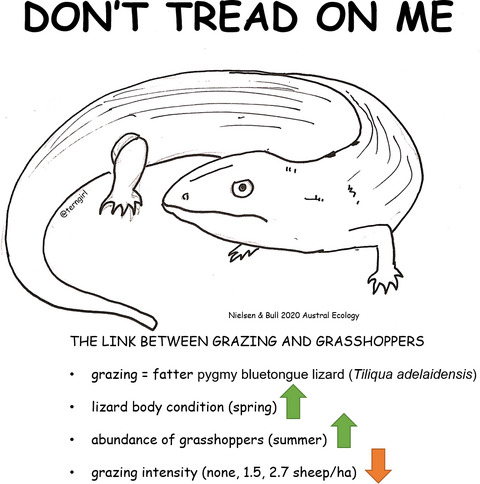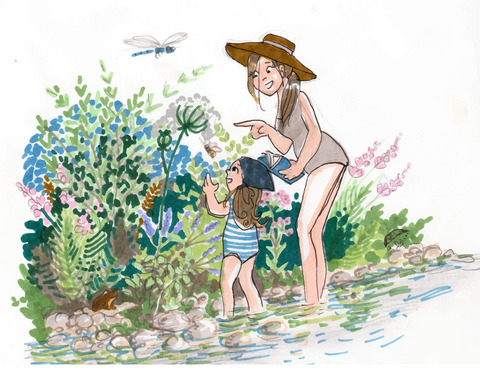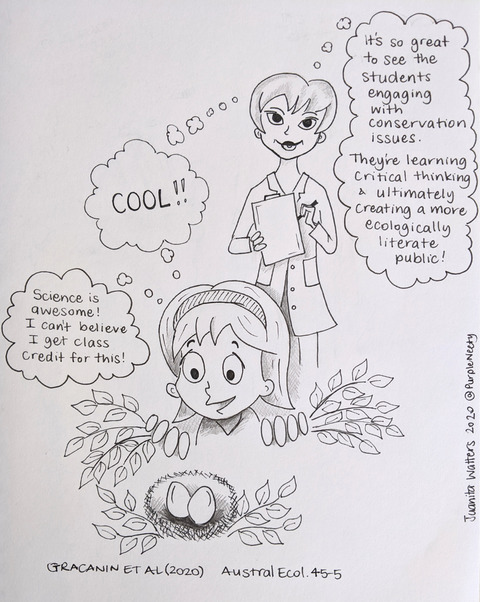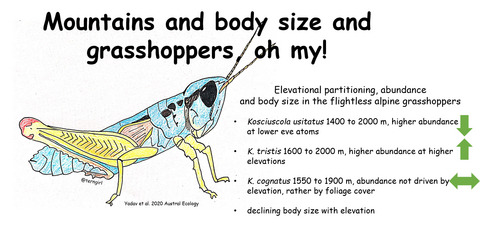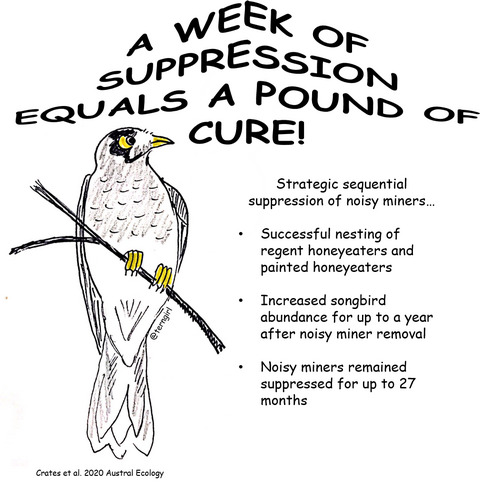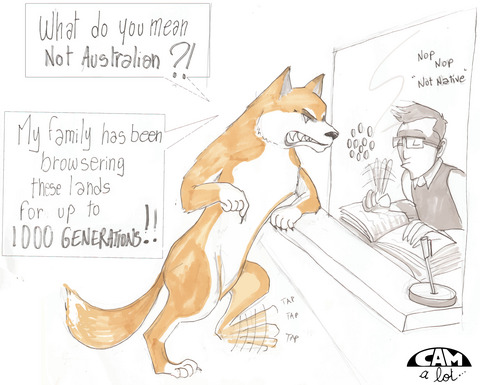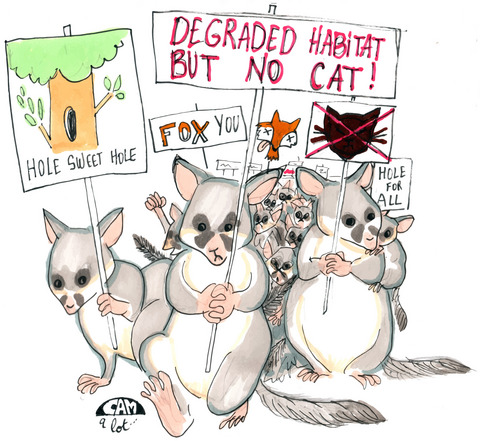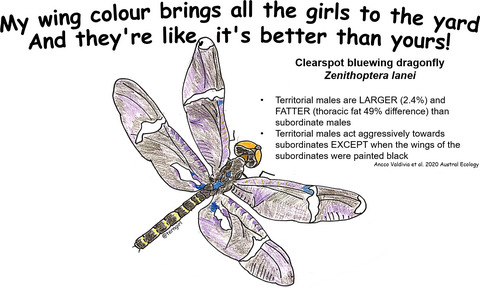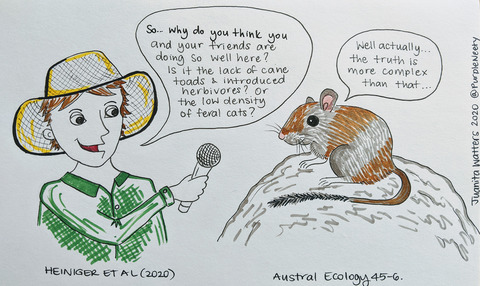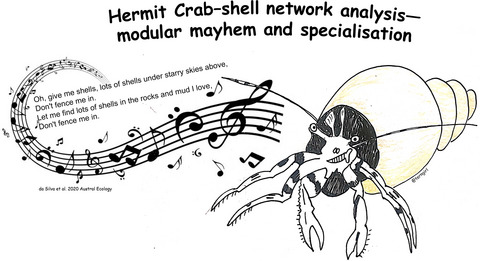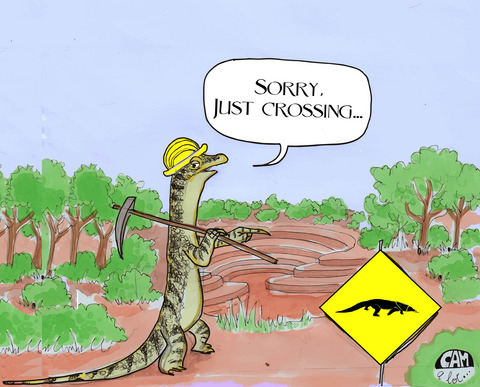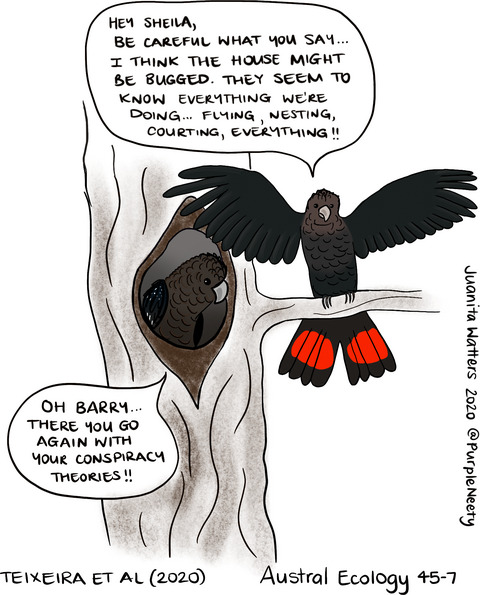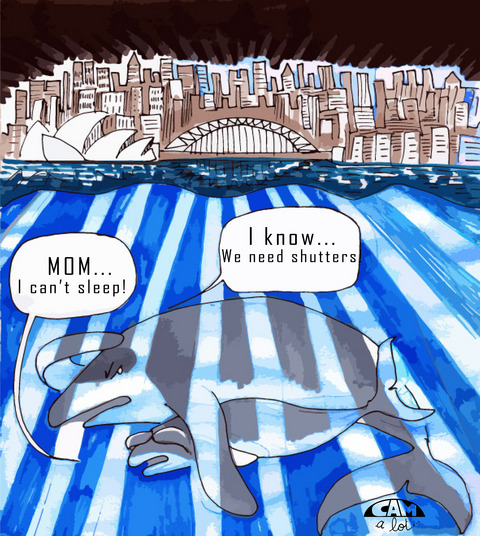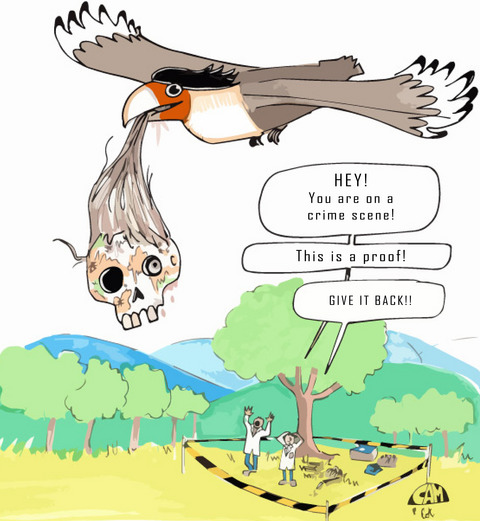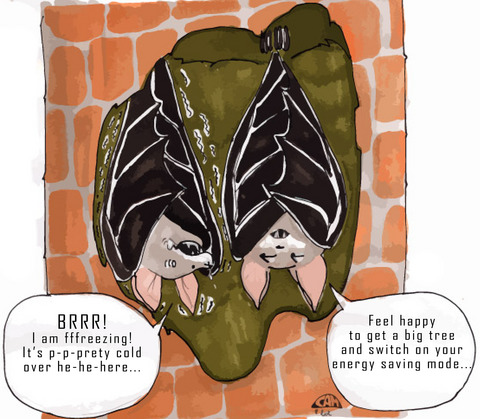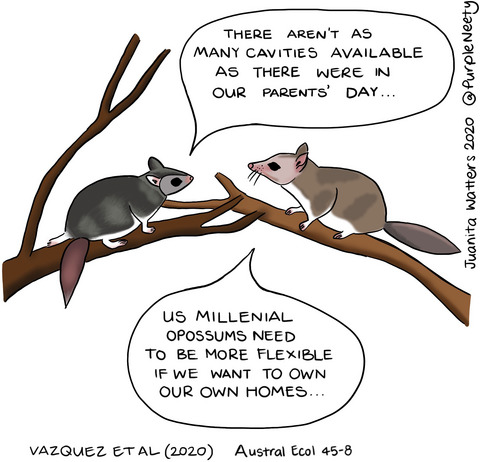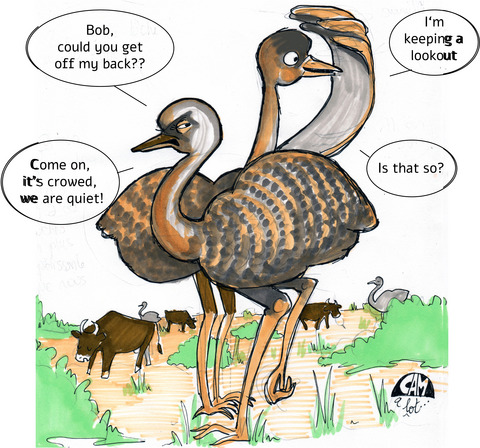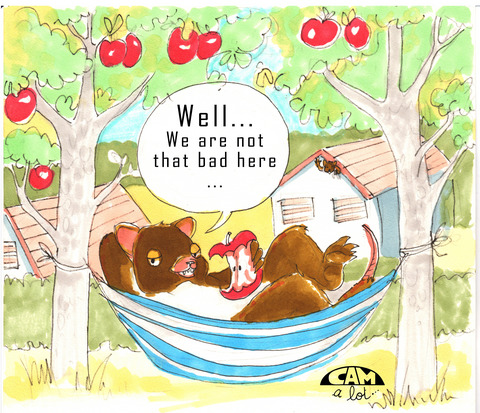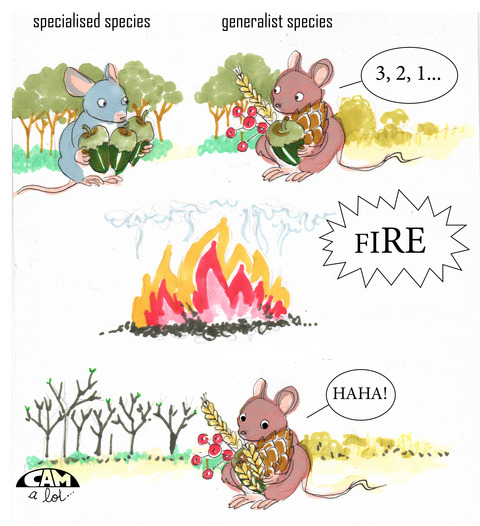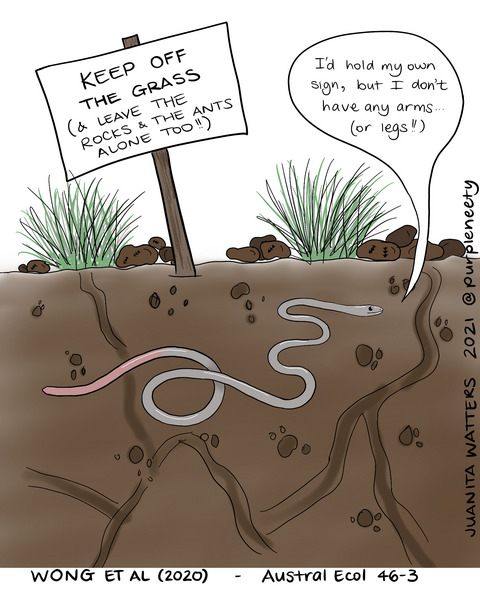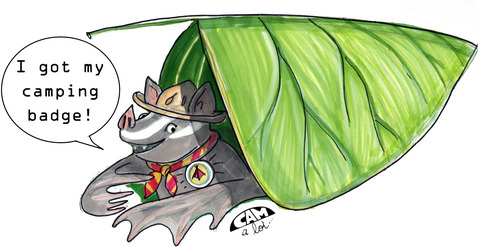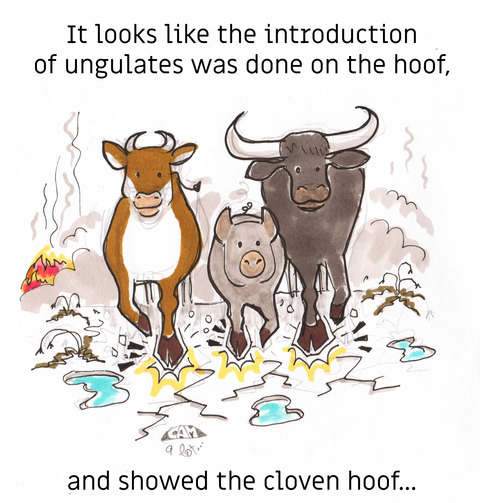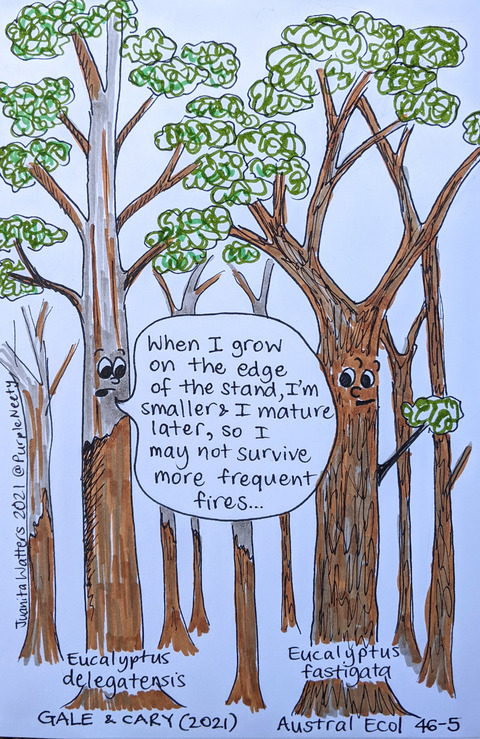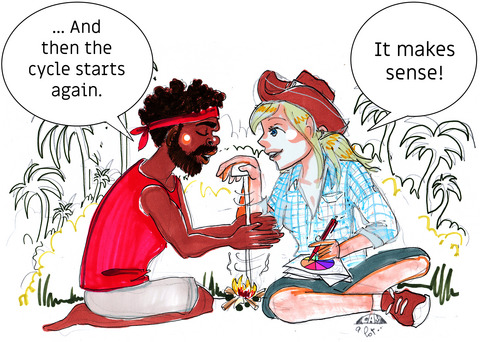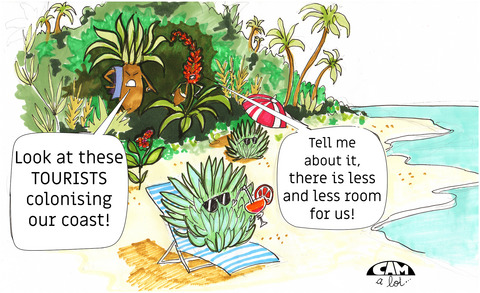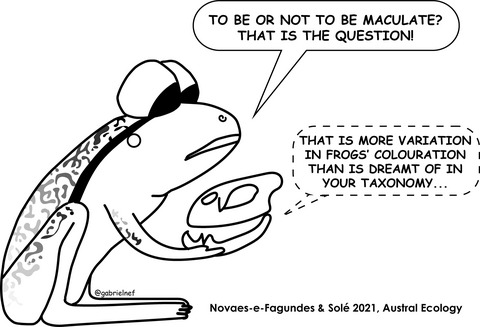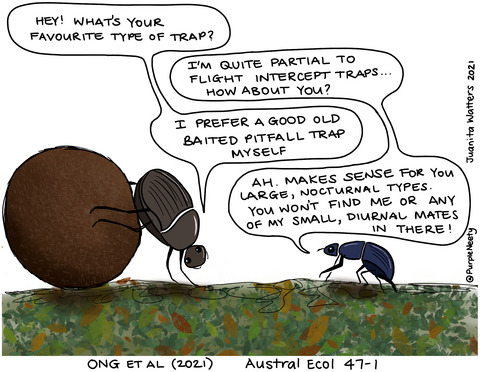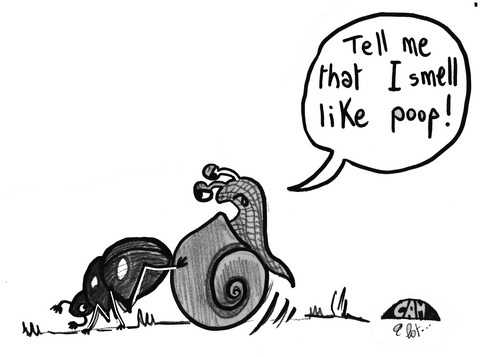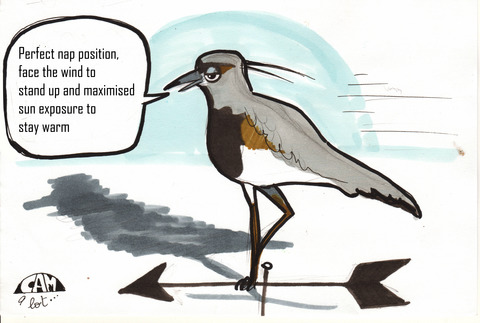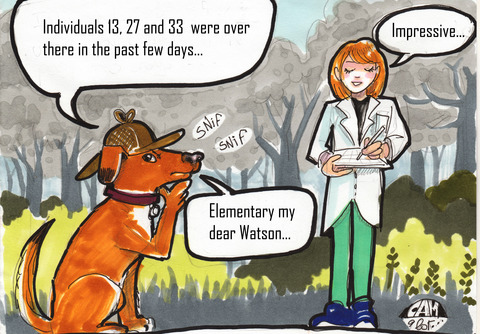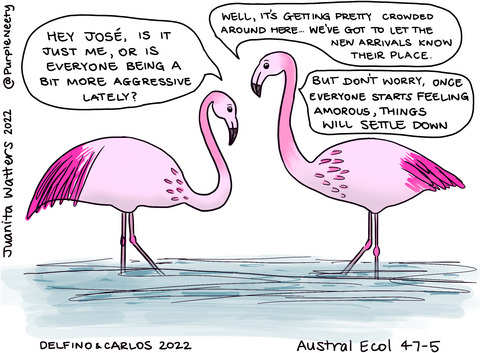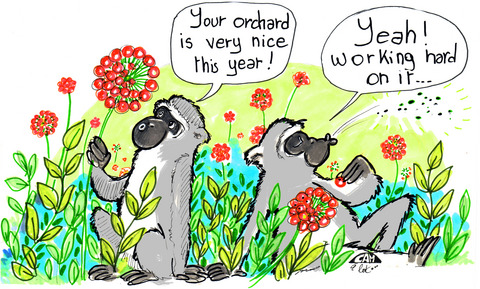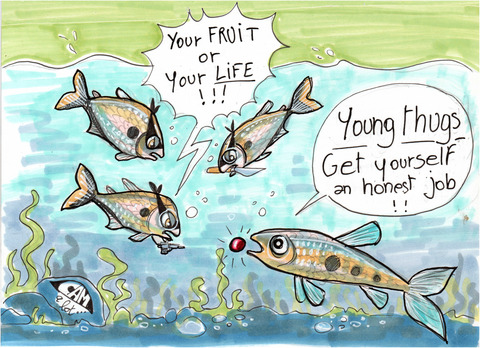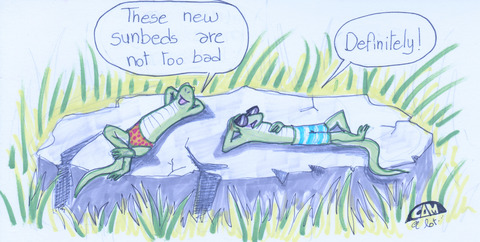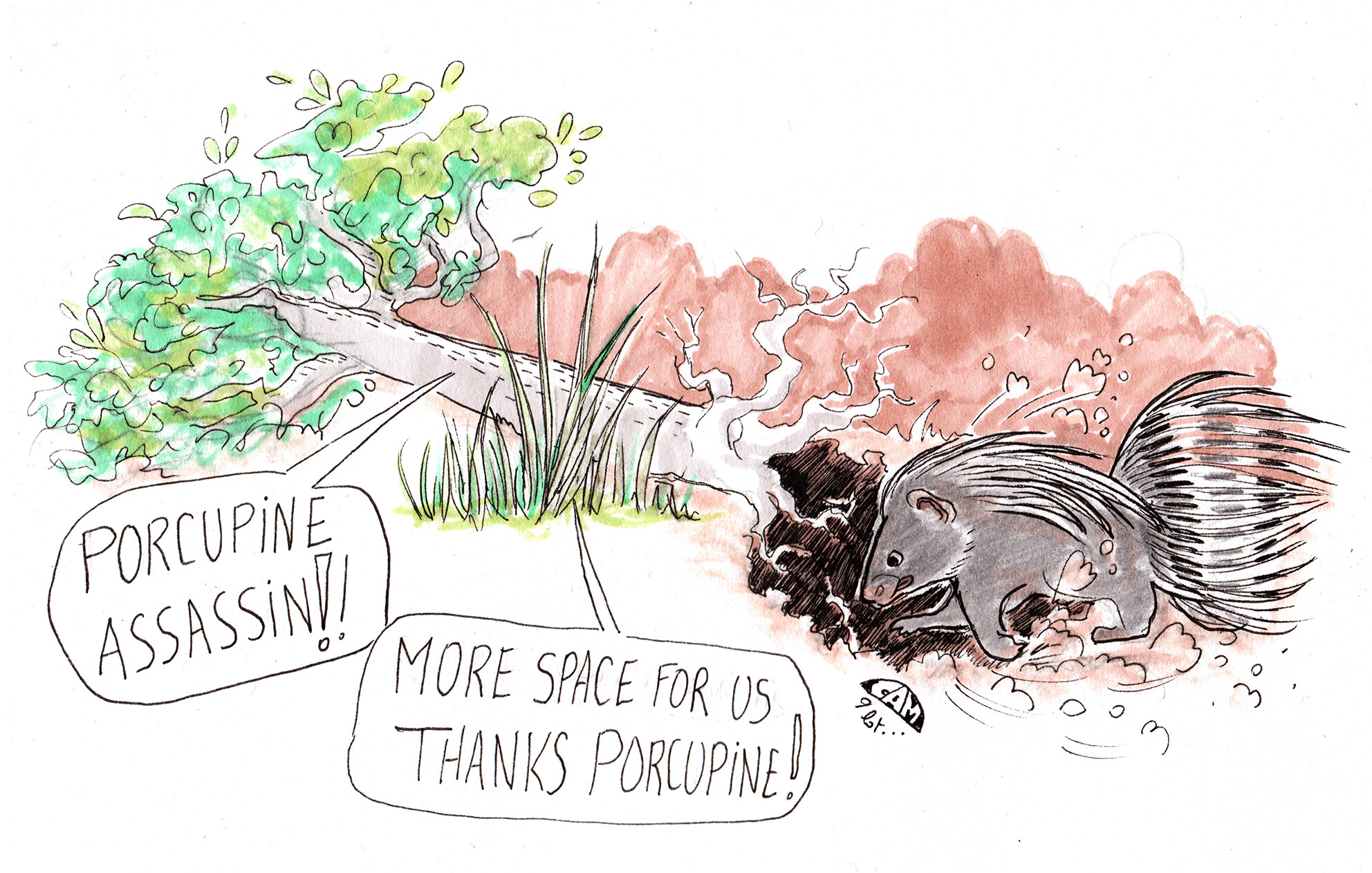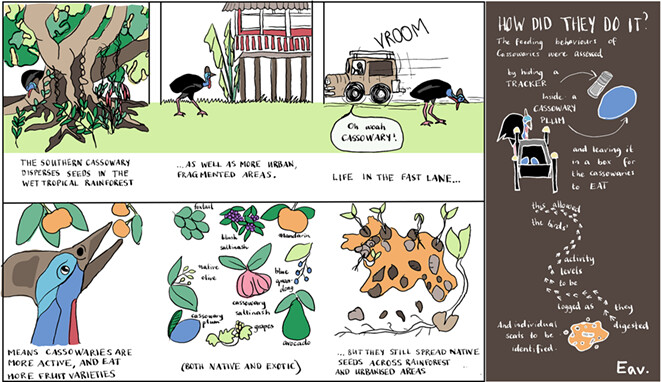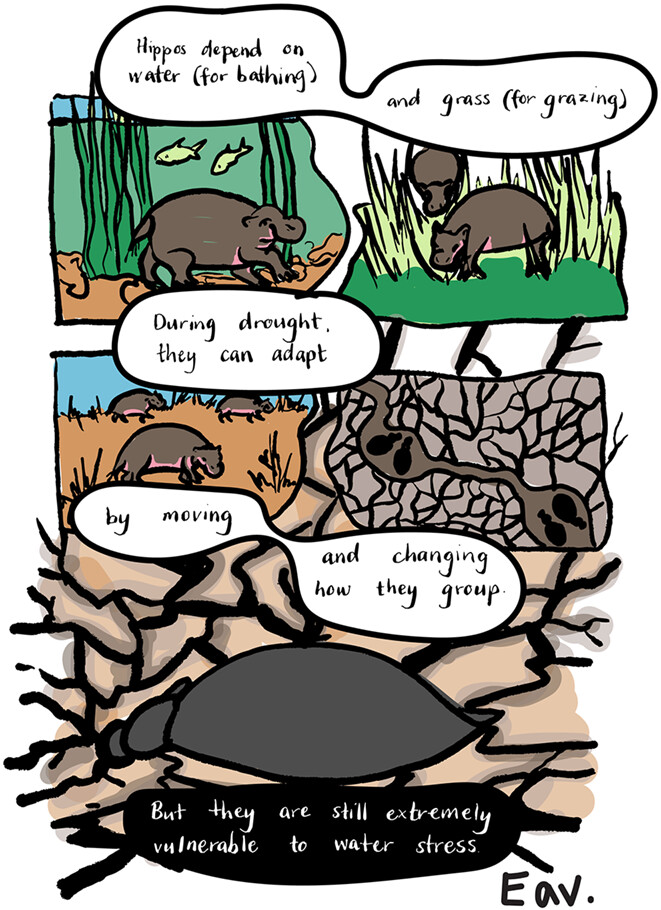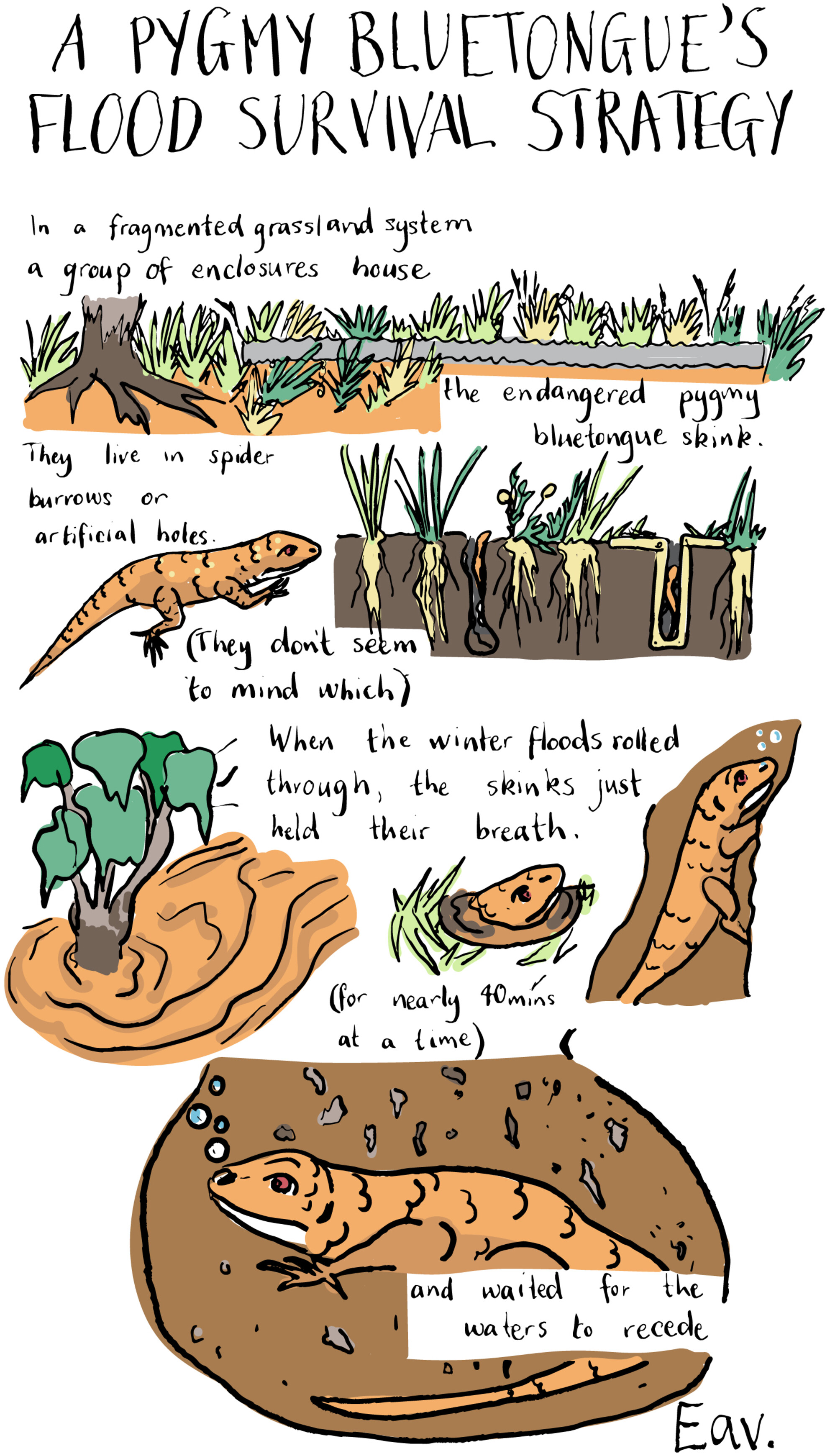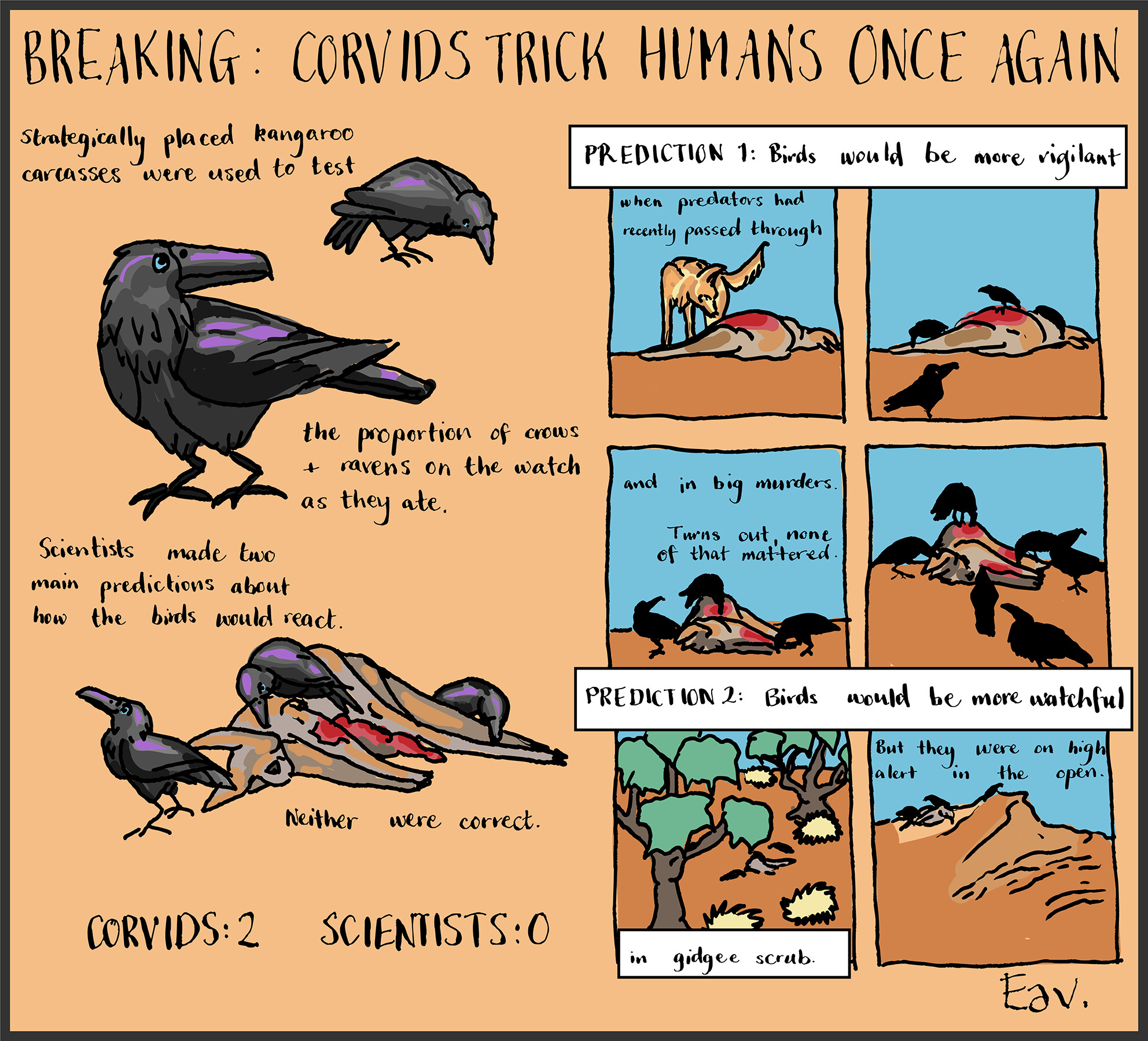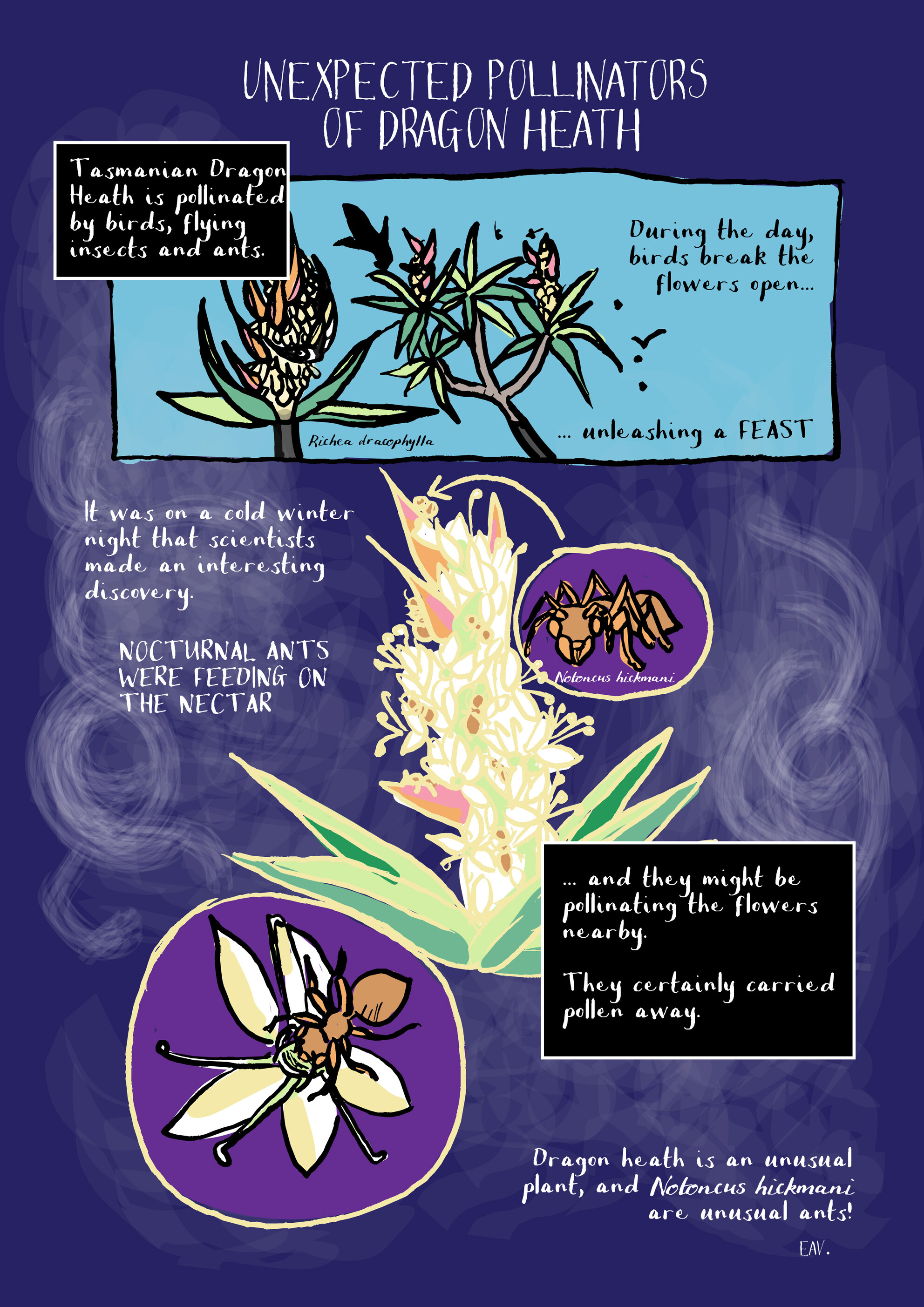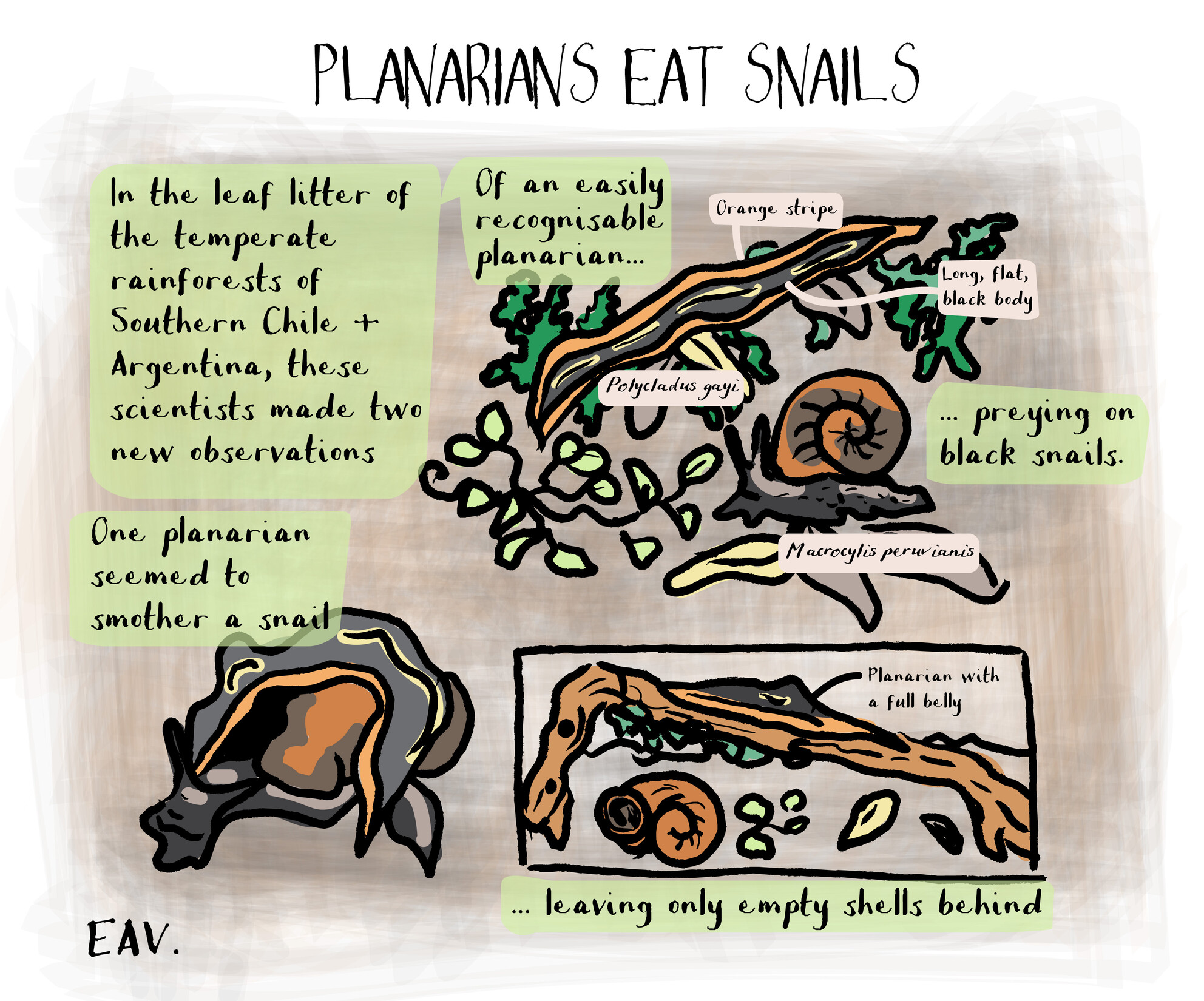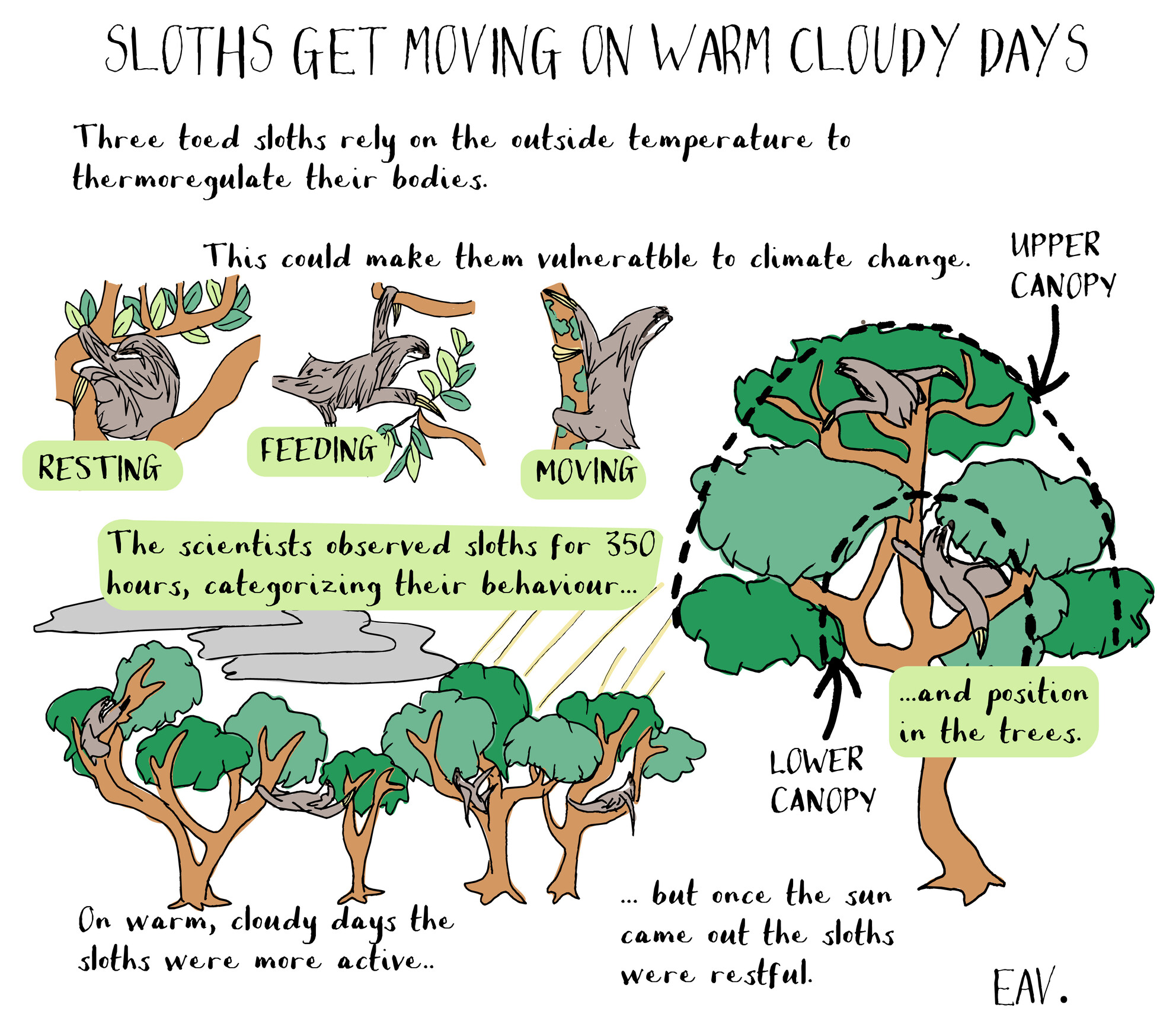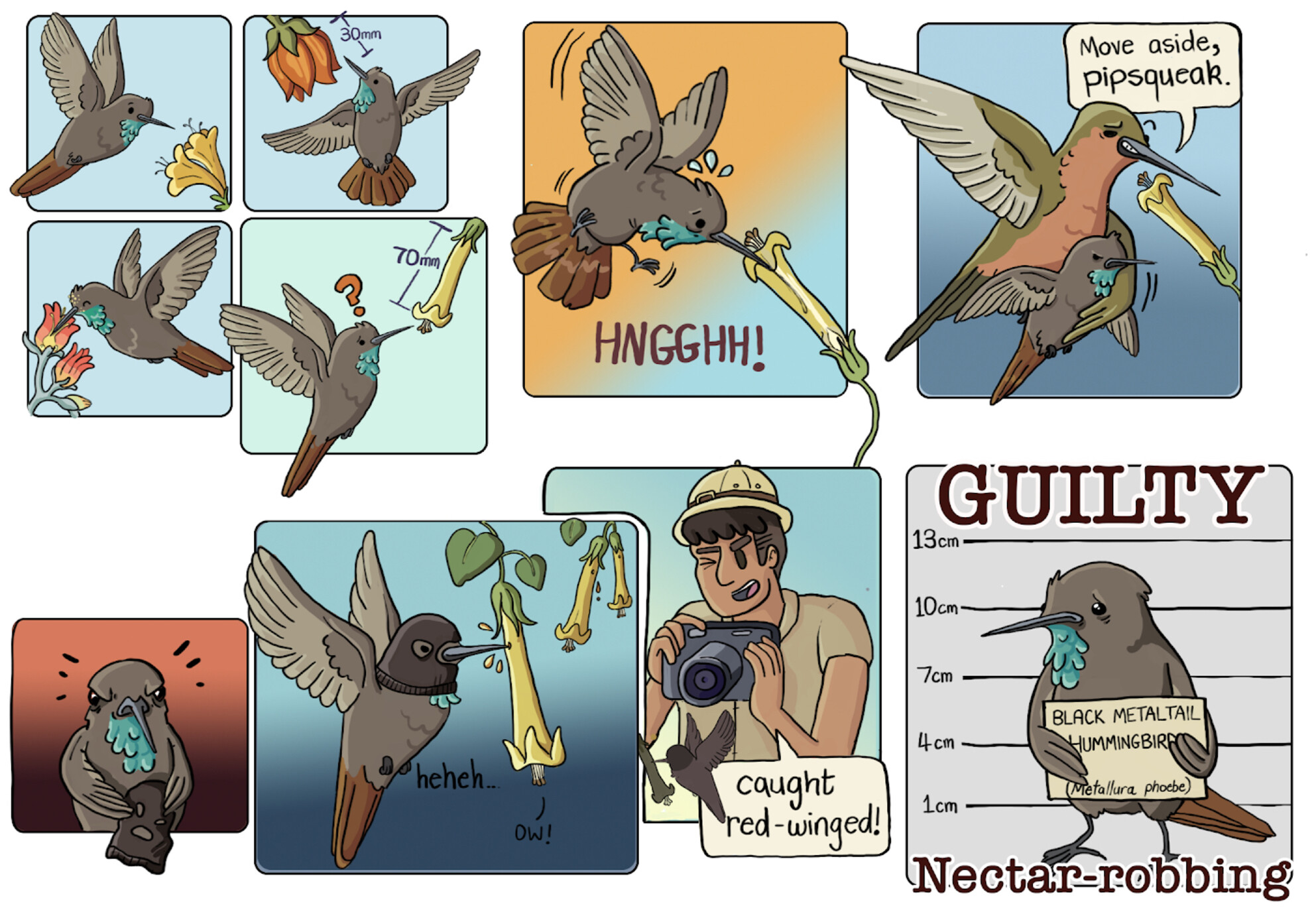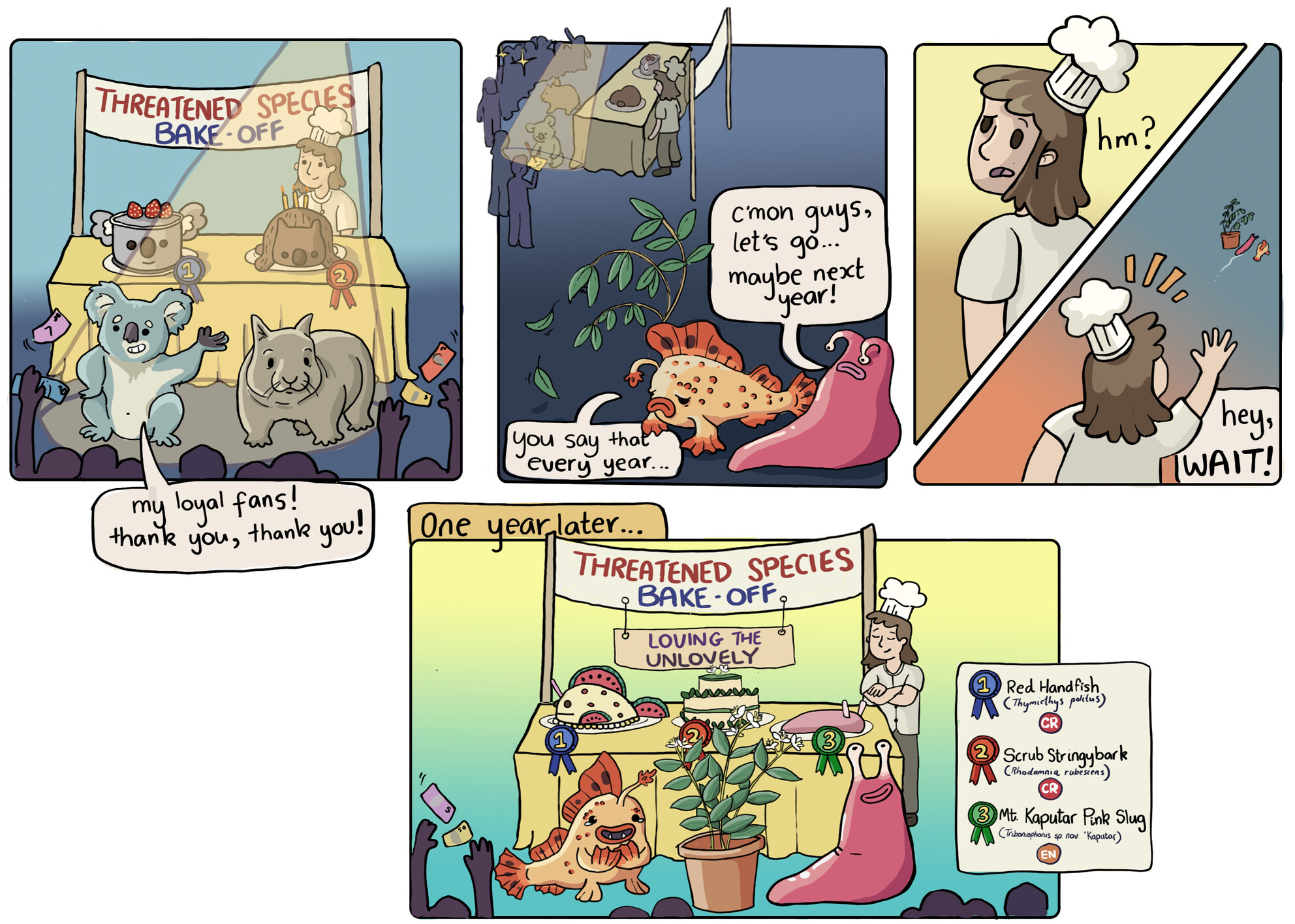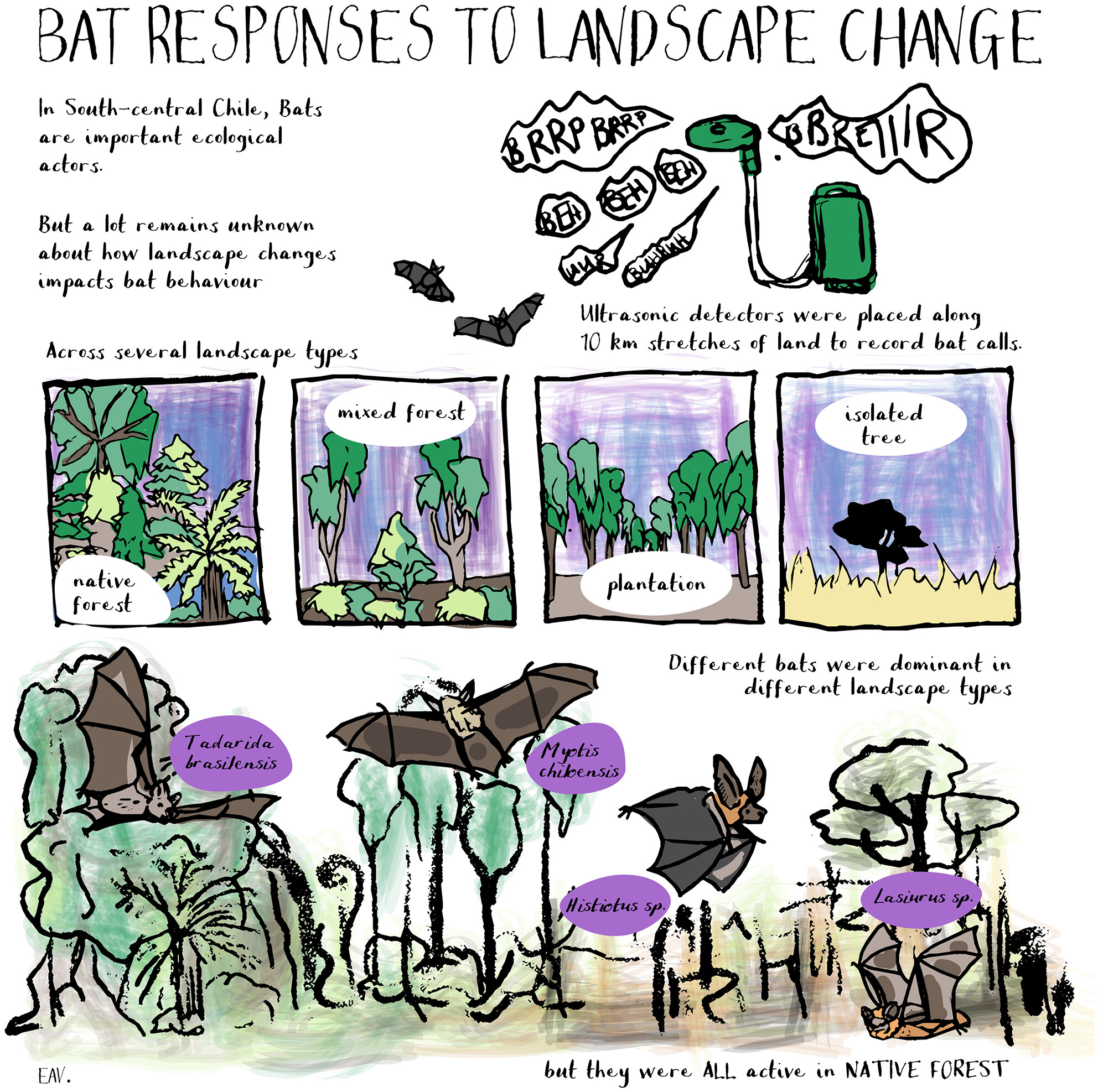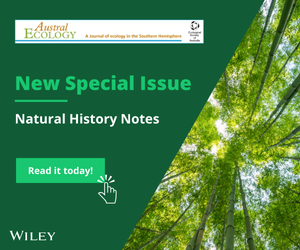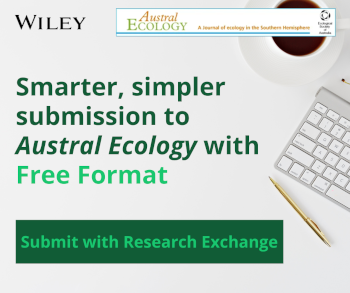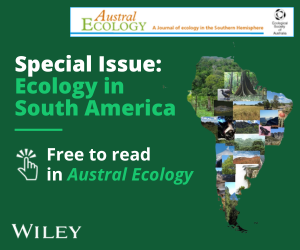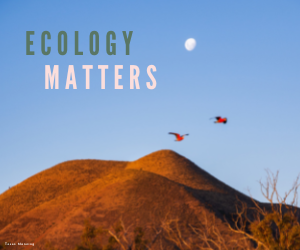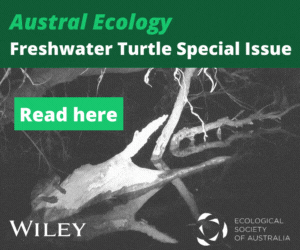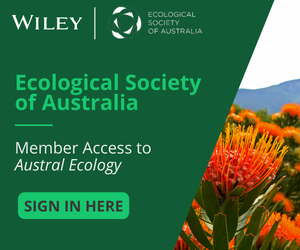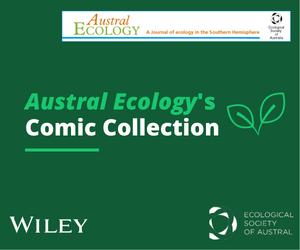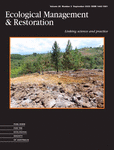
Austral Ecology has been publishing comics alongside a select number of our articles since Volume 44 (2019).
Comics Editor
Caitlyn Forster
Comics Artists
Eav Brennan
Claire Duncan
Camille Le Noëne
Luke S. O'Loughlin
Maggie Watson
Juanita Watters
We have collected all the available comics below by volume:
Predicting invasion risk of 16 species of eucalypts using a risk assessment protocol developed for Brazil
Insight into invasion: Interactions between a critically endangered and invasive crayfish
Are stacked species distribution models accurate at predicting multiple levels of diversity along a rainfall gradient?
- Austral Ecology
- 105-113
- 10.1111/aec.12658
The impact of cattle grazing regimes on tropical savanna bird assemblages
- Austral Ecology
- 187-198
- 10.1111/aec.12663
Towards meaningful monitoring: A case study of a threatened rodent
- Austral Ecology
- 223-236
- 10.1111/aec.12667
Microbat responses to forest decline
- Austral Ecology
- 265-275
- 10.1111/aec.12671
Accuracy of identifications of mammal species from camera trap images: A northern Australian case study
- Austral Ecology
- 473-483
- 10.1111/aec.12681
Understanding predator densities for successful co‐existence of alien predators and threatened prey
- Austral Ecology
- 409-419
- 10.1111/aec.12697
Grass greenness and grass height promote the resource partitioning among reintroduced Burchell's zebra and blue wildebeest in southern Mozambique
- Austral Ecology
- 648-657
- 10.1111/aec.12708
All the eggs in one basket: Are island refuges securing an endangered passerine?
- Austral Ecology
- 523-533
- 10.1111/aec.12693
First records of sea snakes (Elapidae: Hydrophiinae) diving to the mesopelagic zone (>200 m)
- Austral Ecology
- 752-754
- 10.1111/aec.12717
Inverted invasions: Native plants can frequently colonise urban and highly disturbed habitats
- Austral Ecology
- 702-712
- 10.1111/aec.12719
Liana cover in the canopies of rainforest trees is not predicted by local ground‐based measures
- Austral Ecology
- 759-767
- 10.1111/aec.12746
Hemiparasites drive heterogeneity in litter arthropods: Implications for woodland insectivorous birds
- Austral Ecology
- 777-785
- 10.1111/aec.12748
Acoustic stimuli from predators trigger behavioural responses in aggregate caterpillars
- Austral Ecology
- 880-890
- 10.1111/aec.12757
Characteristics of hollows and hollow‐bearing trees in semi‐arid river red gum woodland and potential limitations for hollow‐dependent wildlife
- Austral Ecology
- 995-1004
- 10.1111/aec.12765
Fire resilience of a rare, freshwater crustacean in a fire‐prone ecosystem and the implications for fire management
- Austral Ecology
- 1030-1039
- 10.1111/aec.12770
Contrasting responses of plants and pollinators to woodland disturbance
- Austral Ecology
- 1040-1051
- 10.1111/aec.12771
Chronic stress in superb fairy‐wrens occupying remnant woodlands: Are noisy miners to blame?
- Austral Ecology
- 1139-1149
- 10.1111/aec.12785
Extreme colour variation in the larvae of the executioner clownfrog, Dendropsophus carnifex (Anura: Hylidae), living in nearby ponds of different light exposure and duration
- Austral Ecology
- 1298-1301
- 10.1111/aec.12788
Fire caused demographic attrition of the Tasmanian palaeoendemic conifer Athrotaxis cupressoides
- Austral Ecology
- 1322-1339
- 10.1111/aec.12789
Simulated herbivory counteracts the effects of grass competition on the invasive fireweed (Senecio madagascariensis)
- Austral Ecology
- 1410-1415
- 10.1111/aec.12814
Herb endozoochory by cockatoos: Is ‘foliage the fruit’?
- Austral Ecology
- 122-126
- 10.1111/aec.12835
Digging up the dirt: Quantifying the effects on soil of a translocated ecosystem engineer
- Austral Ecology
- 97-108
- 10.1111/aec.12833
Identifying a surrogate metric for monitoring the population status of a secretive habitat specialist, the heath skink Liopholis multiscutata, in south-eastern Australia
- Austral Ecology
- 206-214
- 10.1111/aec.12848
Camponotus ants mine sand for vertebrate urine to extract nitrogen
- Austral Ecology
- 168-176
- 10.1111/aec.12840
Modelling the climate suitability of green carpenter bee (Xylocopa aerata) and its nesting hosts under current and future scenarios to guide conservation efforts
- Austral Ecology
- 271-282
- 10.1111/aec.12853
Space use and temporal partitioning of sympatric Tasmanian devils and spotted‐tailed quolls
- Austral Ecology
- 355-365
- 10.1111/aec.12865
Proposing a new hypothesis: Rickettsia spp. as a mechanism maintaining parapatry between two Australian reptile tick species
- Austral Ecology
- 488-492
- 10.1111/aec.12897
Effects of grazing regime on the relative body mass of the endangered pygmy bluetongue lizard (Tiliqua adelaidensis)
- Austral Ecology
- 460-467
- 10.1111/aec.12816
Understanding how nature works: Five pathways towards a more ecologically literate world – A perspective
- Austral Ecology
- 510-519
- 10.1111/aec.12883
An artificial bird nest experiment in urban environments: Lessons from a school‐based citizen science programme
- Austral Ecology
- 523-528
- 10.1111/aec.12859
Elevational partitioning in species distribution, abundance and body size of Australian alpine grasshoppers (Kosciuscola)
- Austral Ecology
- 609-620
- 10.1111/aec.12876
Sustained and delayed noisy miner suppression at an avian hotspot
- Austral Ecology
- 636-643
- 10.1111/aec.12878
Critiquing the notion of a species natural range in an era of unprecedented change
- Austral Ecology
- 672-674
- 10.1111/aec.12926
Can reintroductions to degraded habitat succeed? A test using the common brushtail possum
- Austral Ecology
- 675-690
- 10.1111/aec.12880
Differences in size and energy content affect the territorial status and mating success of a neotropical dragonfly
- Austral Ecology
- 748-758
- 10.1111/aec.12891
Status of mammals on Groote Eylandt: Safe haven or slow burn?
- Austral Ecology
- 759-772
- 10.1111/aec.12892
Redefining life expectancy and maximum lifespan for wildlife management
- Austral Ecology
- 855-857
- 10.1111/aec.12931
The hermit crab–shell relationship through the lens of interaction networks: The use of network metrics and species role across communities
- Austral Ecology
- 896-908
- 10.1111/aec.12903
Using monitors to monitor ecological restoration: Presence may not indicate persistence
- Austral Ecology
- 921-932
- 10.1111/aec.12905
Nest-associated vocal behaviours of the south-eastern red-tailed black cockatoo, Calyptorhynchus banksii graptogyne, and the Kangaroo Island glossy black cockatoo, C. lathami halmaturinus
- Austral Ecology
- 990-1006
- 10.1111/aec.12921
Knowledge exchange to improve research and management of the impacts of artificial light at night
- Austral Ecology
- 1059-1061
- 10.1111/aec.12948
Vertebrate scavengers alter the chronology of carcass decay
- Austral Ecology
- 1103-1109
- 10.1111/aec.12939
Roosting ecology of the southernmost bats, Myotis chiloensis and Histiotus magellanicus, in southern Tierra del Fuego, Chile
- Austral Ecology
- 1169-1178
- 10.1111/aec.12950
Austral Opossum adjusts to life in second‐growth forests by nesting outside cavities
- Austral Ecology
- 1179-1182
- 10.1111/aec.12927
Some like it odd: Long‐term research reveals unusual behaviour in the flightless Kagu of New Caledonia
- Austral Ecology
- 151-154
- 10.1111/aec.12962
Biting off more than you can chew: Attempted predation on a human by a giant snake (Simalia amethistina)
- Austral Ecology
- 159-162
- 10.1111/aec.12956
Is the presence of a threatened arboreal mammal in residential areas related to remnant habitats?
- Austral Ecology
- 181-185
- 10.1111/aec.12953
Effectiveness of bat boxes for bat conservation and insect suppression in a Western Australian urban riverine reserve
- Austral Ecology
- 186-191
- 10.1111/aec.12980
Graphical Abstract
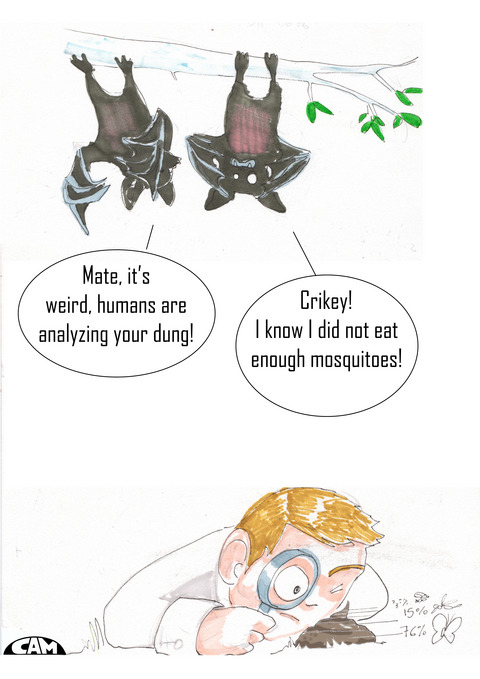
Urban wetlands are important habitat for wildlife, particularly insectivorous bats which provide a key ecosystem service in suppressing insects. We took advantage of occupied bat boxes within an urban riverine reserve to determine the roosting bat species and their diet using non-invasive DNA metabarcoding of bat faecal samples. We detected only one bat species (Chalinolobus gouldii) roosting in the bat boxes, foraging on >700 unique prey, representing seven insect orders.
Rodent assemblage composition as indicator of fire severity in a protected area of south‐central Chile
- Austral Ecology
- 249-260
- 10.1111/aec.12975
Agricultural modification to vegetation drives presence and abundance of a threatened fossorial legless lizard
- Austral Ecology
- 437-448
- 10.1111/aec.12986
Camera trap detection of mycophagy among co‐occurring vertebrates
- Austral Ecology
- 496-500
- 10.1111/aec.12988
Nocturnal foraging and activity by diurnal lizards: Six species of day geckos (Phelsuma spp.) using the night-light niche
- Austral Ecology
- 501-506
- 10.1111/aec.13012
Graphical Abstract
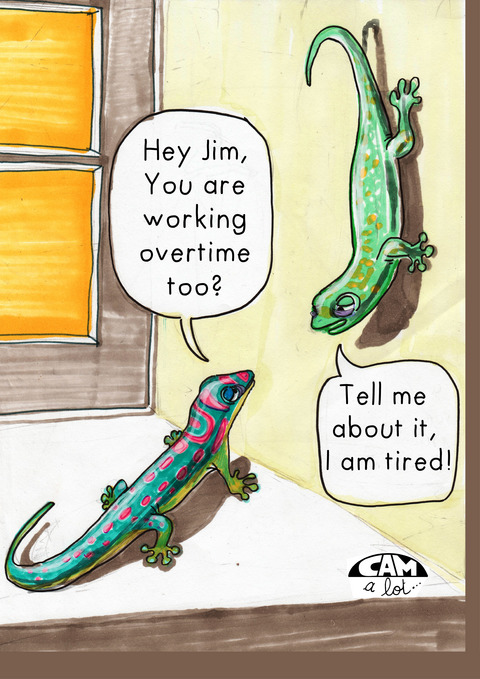
Urbanisation and expanding human landscapes have increased the amount of artificial light at night (ALAN), which can affect the behaviour and ecology of diurnal taxa. This natural history note reports novel observations of six species of diurnal day geckos (Phelsuma spp.) engaging in activity within the 'night-light niche', in both native and invasive populations.
United colours of the city: A review about urbanisation impact on animal colours
- Austral Ecology
- 670-679
- 10.1111/aec.13005
Graphical Abstract
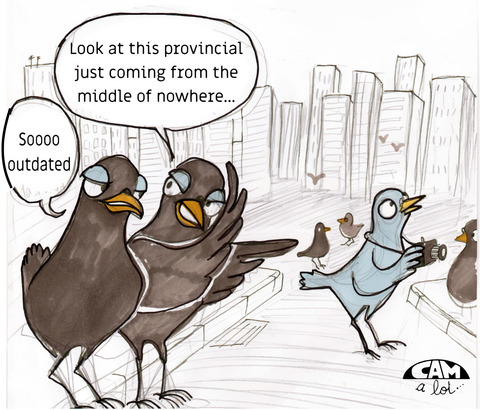
This is the first review about the relationship between urbanisation and animal colours. At the intraspecific level, urban melanism (a) and urban dullness (b) have been found in most of studies. Analysis of colour variation at the interspecific level and in the Southern Hemisphere is scarce and deserves more attention.
Terrestrial slug uses a vertical bridge of mucus to descend rapidly from heights
- Austral Ecology
- 680-682
- 10.1111/aec.13011
Graphical Abstract

While terrestrial slugs generally move across surfaces on a film of mucus, they are also capable of producing mucus threads to move vertically through the air in a manner similar to spiders. In our study, we report on the production of mucus threads by the striped field slug, Lehmannia nyctelia, which are tethered on either end to produce a vertical bridge for locomotion. This is in contrast to previous reports of such threads among terrestrial slugs which are only attached at one end to overlying surfaces and may be adaptive by stabilising individuals and preventing excessive sideways movements during descent.
First description of a tent used by Platyrrhinus recifinus
- Austral Ecology
- 692-695
- 10.1111/aec.13026
An overview of the impacts of feral cattle, water buffalo and pigs on the savannas, wetlands and biota of northern Australia
- Austral Ecology
- 699-712
- 10.1111/aec.13046
Stand boundary effects on obligate seeding Eucalyptus delegatensis regeneration and fuel dynamics following high and low severity fire: Implications for species resilience to recurrent fire
- Austral Ecology
- 802-817
- 10.1111/aec.13024
Novel habitat associations and seasonality in threatened Mitchell’s water monitors (Varanus mitchelli): Implications for conservation
- Austral Ecology
- 871-875
- 10.1111/aec.13029
Graphical Abstract

Mitchell’s water monitors (Varanus mitchelli) are a small to medium-sized (<1 m TL) Australian varanid lizard endemic to northern Western Australia and the Northern Territory, extending just into north-western Queensland, which have suffered dramatic declines following the arrival of cane toads. Here, we present observations of V. mitchelli from previously unreported saline and brackish habitats, as well as information on the cryptic behaviour and seasonal activity of this threatened species in Darwin, Northern Territory, and discuss the conservation implications of these natural history observations.
Co‐producing a fire and seasons calendar to support renewed Indigenous cultural fire management
- Austral Ecology
- 1011-1029
- 10.1111/aec.13034
Quantifying invasion degree by alien plants species in Reunion Island
- Austral Ecology
- 1025-1037
- 10.1111/aec.13048
To be or not to be maculate? – Colour/pattern change in the neotropical frog genus Phyllodytes
- Austral Ecology
- 1170-1174
- 10.1111/aec.13038
Graphical Abstract
Trap type affects dung beetle taxonomic and functional diversity in Bornean tropical forests
An endemic dung beetle species feeding on kauri snail carrion in Northland, New Zealand
- Austral Ecology
- 127-130
- 10.1111/aec.13125
Graphical Abstract
Burning for grassland pollination: Recently burned patches promote plant flowering and insect pollinators
- Austral Ecology
- 491-506
- 10.1111/aec.13108
Graphical Abstract
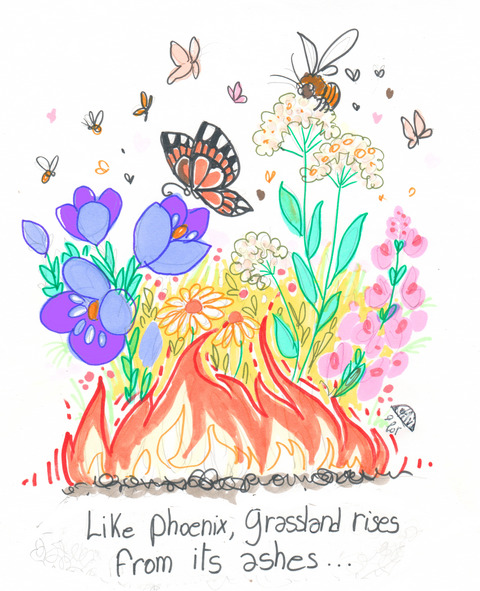
We investigated patterns and drivers of plant flowering and flower insect visitor communities in a chronosequence of patches from three different time-since-fire categories in Southern Brazilian grasslands. Pollinator insects were benefited by floral resource aggregation in freshly-burnt (FB) patches, increasing in abundance (bees and butterflies) and species richness (bees). Furthermore, plant species flowering and bee species composition varied between FB and old-burnt (OB), but did not differ from intermediate-burnt (IB) grasslands. Altogether, these results indicate the importance FB patches to sustain pollination services, and support that a mosaic of grasslands from different times-since-fire should be considered for grassland conservation.
Rapid gain and loss of predator recognition by an evolutionarily naïve lizard
- Austral Ecology
- 641-652
- 10.1111/aec.13148
Quantity versus quality: A balance between egg and clutch size among Australian amphibians in relation to other life-history variables
- Austral Ecology
- 685-697
- 10.1111/aec.13154
Graphical Abstract
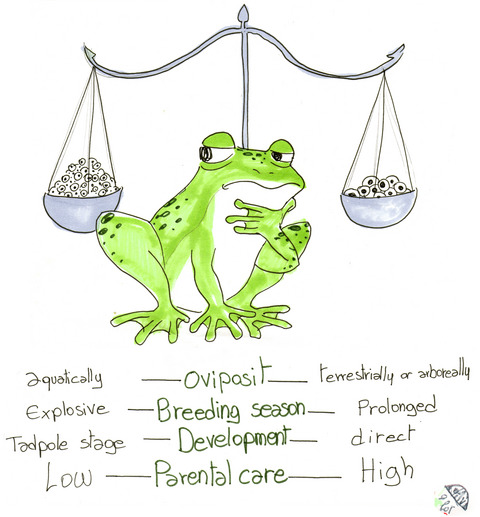
While an inverse relationship between egg and clutch sizes has been found repeatedly across animal groups, few studies have investigated this relationship in the context of other variables. We use a comparative phylogenetic approach to look at the influence of environmental selection pressures and life history traits on the trade-off between egg and clutch sizes among the Australian amphibians. We show that the shift towards producing larger eggs in smaller clutches is associated with the transition away from the ancestral amphibian reproductive pattern, providing a framework for future examinations of this trade-off among anurans.
Shorebirds adjust resting orientation in response to solar radiation and wind speed
- Austral Ecology
- 765-769
- 10.1111/aec.13170
Detection dogs provide a powerful method for conservation surveys
- Austral Ecology
- 894-901
- 10.1111/aec.13162
Intra-annual variation in activity budgets of a wild Chilean Flamingo (Phoenicopterus chilensis) population in Southern Brazil
- Austral Ecology
- 971-982
- 10.1111/aec.13180
Seed dispersal by monkey spitting in Scadoxus (Amaryllidaceae): Fruit selection, dispersal distances and effects on seed germination
- Austral Ecology
- 1029-1036
- 10.1111/aec.13193
Fish thieves: An alternative tactic of food capture in a Neotropical frugivorous species (Brycon falcatus)
- Austral Ecology
- 1140-1143
- 10.1111/aec.13201
Rock supplementation as an ecological restoration strategy for temperate grassland reptiles
- Austral Ecology
- 1402-1414
- 10.1111/aec.13219
The impacts of Cape porcupines on woody plant mortality
- Austral Ecology
- 1168-1177
- 10.1111/aec.13329
The southern cassowary (Casuarius casuarius johnsonii) remains an important disperser of native plants in fragmented rainforest landscapes
- Austral Ecology
- 787-802
- 10.1111/aec.13309
Hippos alter their aggregations to mitigate density‐dependent drought effects
- Austral Ecology
- 969-982
- 10.1111/aec.13317
Influences on koala habitat selection across four local government areas on the far north coast of NSW
- Austral Ecology
- 928-951
- 10.1111/aec.13313
Hyperepilithics—An overlooked life form of vascular plants on tropical vertical rock walls
- Austral Ecology
- 1074-1082
- 10.1111/aec.13352
Graphical Abstract
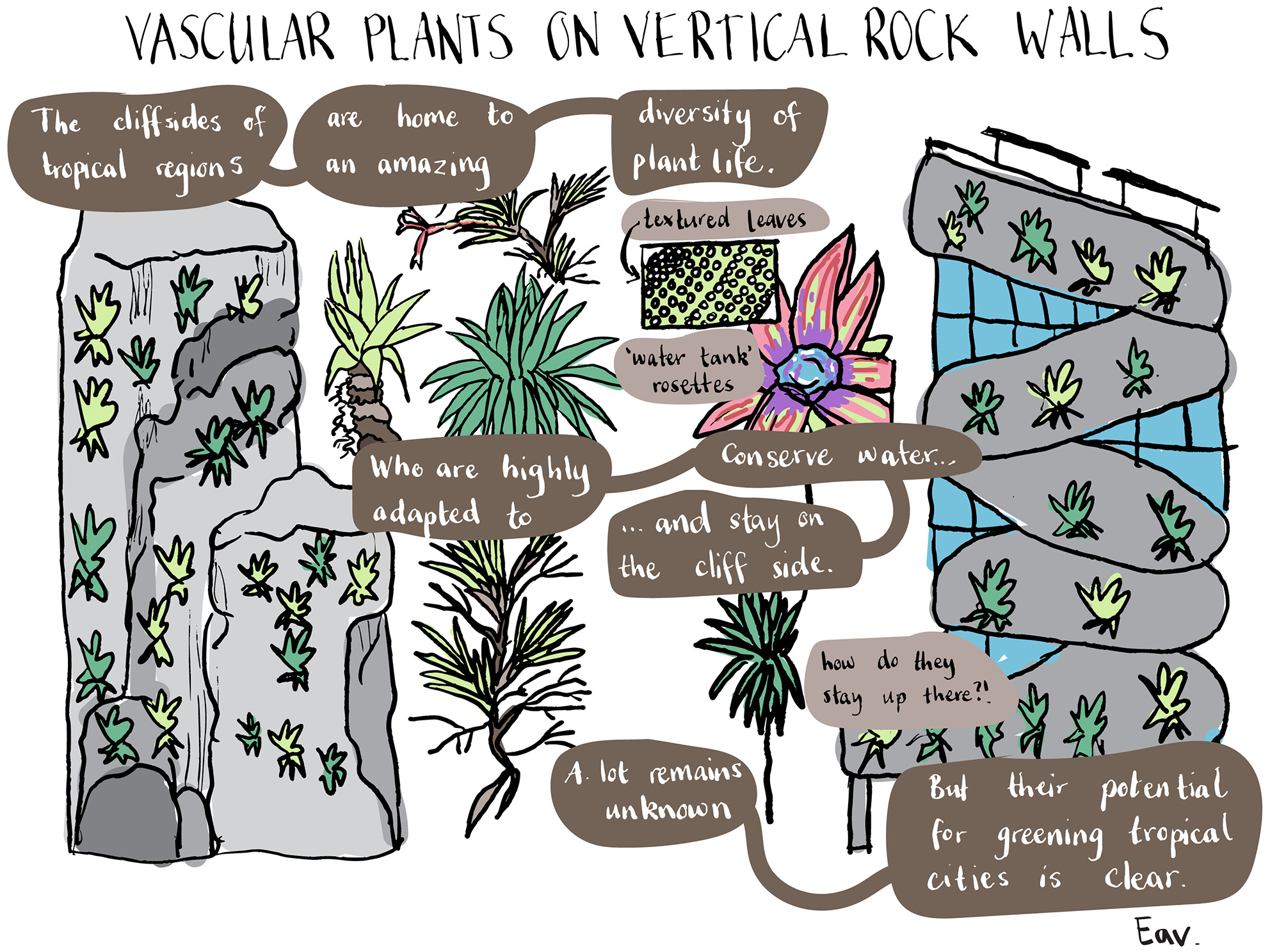
In this study, we describe for the first time the hyperepilithic life form, that is vascular plants adapted and restricted to growing on vertical rock walls habitat. An overview of this habitat, the hyperepilithics life form and a comparison with similar paleotropical habitats are provided. Hyperepilithics are in particular present on Brazilian inselbergs and dominated by Bromeliaceae, and we highlight the potential of these hyperepilitics for a sustainable urban ‘vertical gardening’, for tropical megacities.
Ineffectiveness of plastic mesh for protecting artificial freshwater turtle nests from red fox (Vulpes vulpes) predation
- Austral Ecology
- 1547-1558
- 10.1111/aec.13362
Graphical Abstract
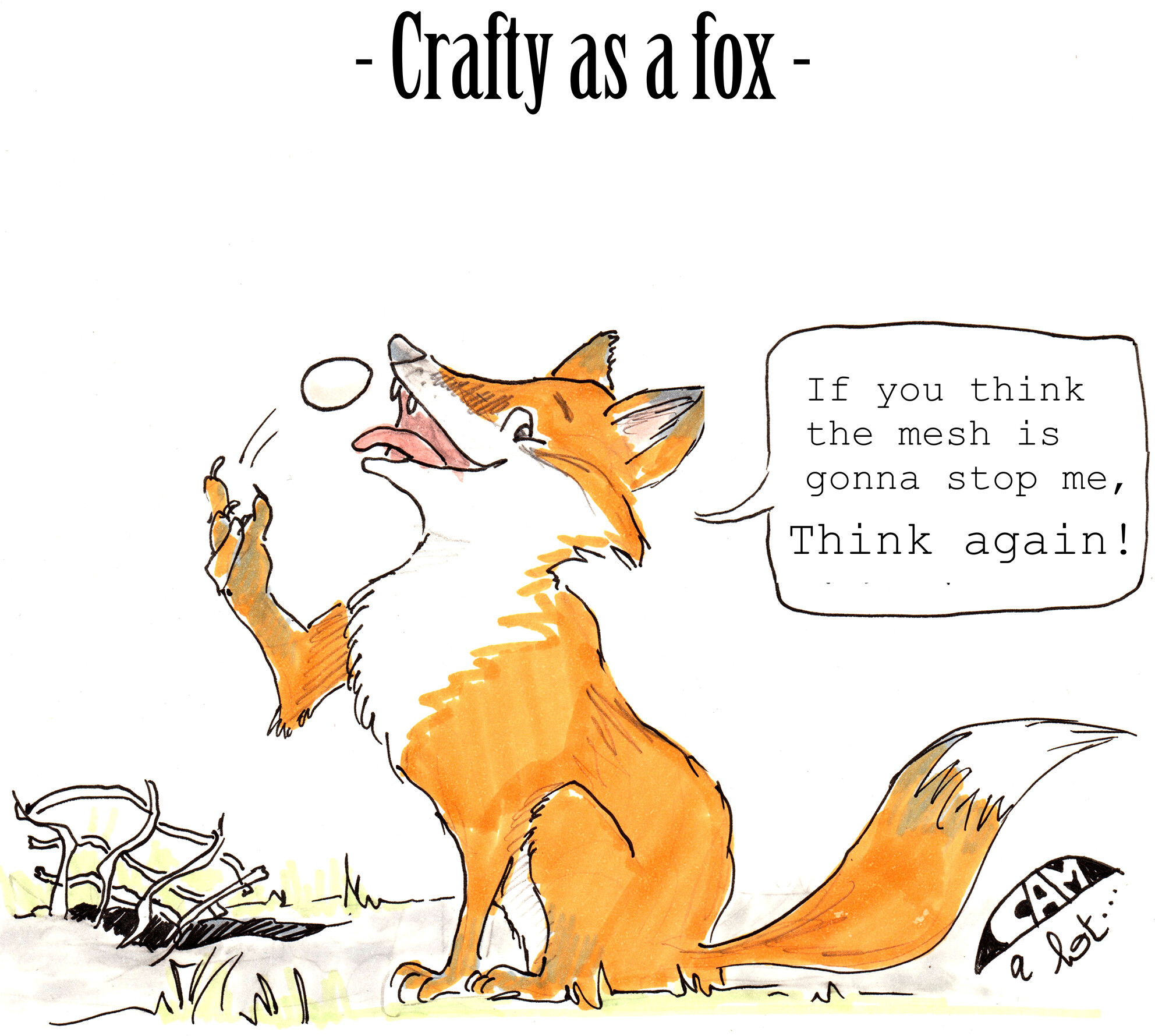
We tested the effectiveness of plastic mesh for protecting simulated freshwater turtle nests from invasive foxes. We used the design to also determine whether nest protection drove foxes to ‘give up’ foraging on nests, following aspects of optimal foraging theory. The mesh proved ineffective, but this may be because foxes in this area have learned to defeat plastic mesh since it has been used to protect real turtle nests for several years.
Hold your breath: Observations of the endangered pygmy bluetongue (Tiliqua adelaidensis) submerged in flooded burrows
- Austral Ecology
- 1200-1204
- 10.1111/aec.13351
Patch size and breeding status influence movement patterns in the threatened Malleefowl (Leipoa ocellata)
- Austral Ecology
- 904-927
- 10.1111/aec.13311
Graphical Abstract
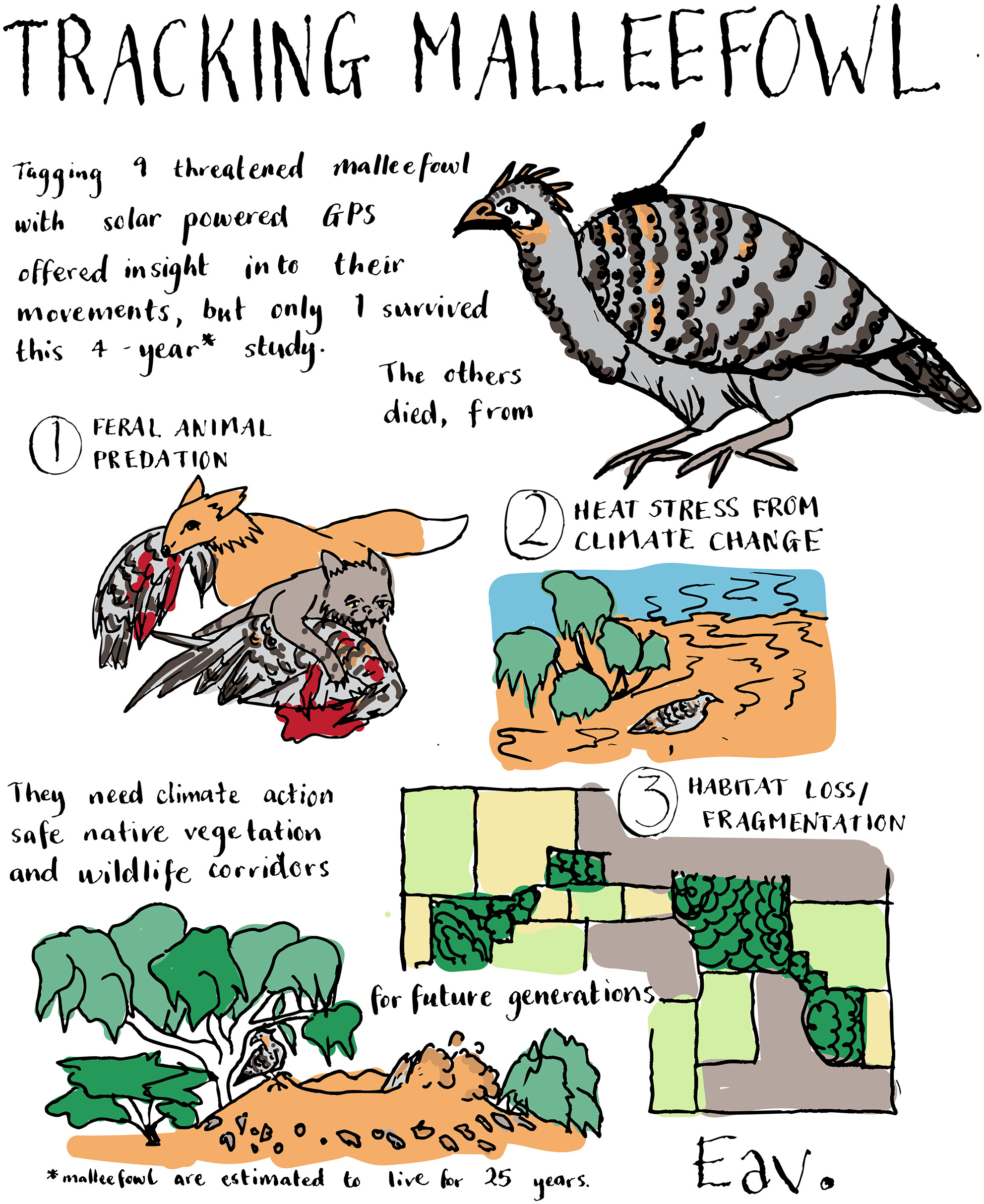
Movement and dispersal of the threatened Malleefowl (Leipoa ocellata) in fragmented landscapes is critical for their survival. We used GPS telemetry to collect movement data and found that movement patterns were significantly influenced by breeding status, the size of the native vegetation patch and environmental factors. Malleefowl movement may be limited by patch size and decreases during hot, dry periods, possibly affecting breeding success, but improved habitat continuity may facilitate dispersal and persistence.
Habitat but not group size or recent predator activity affect corvid collective vigilance at carcasses
- Austral Ecology
- 999-1014
- 10.1111/aec.13323
Herbivores but not vegans: Deer as nest predators
- Austral Ecology
- 1460-1465
- 10.1111/aec.13374
Graphical Abstract
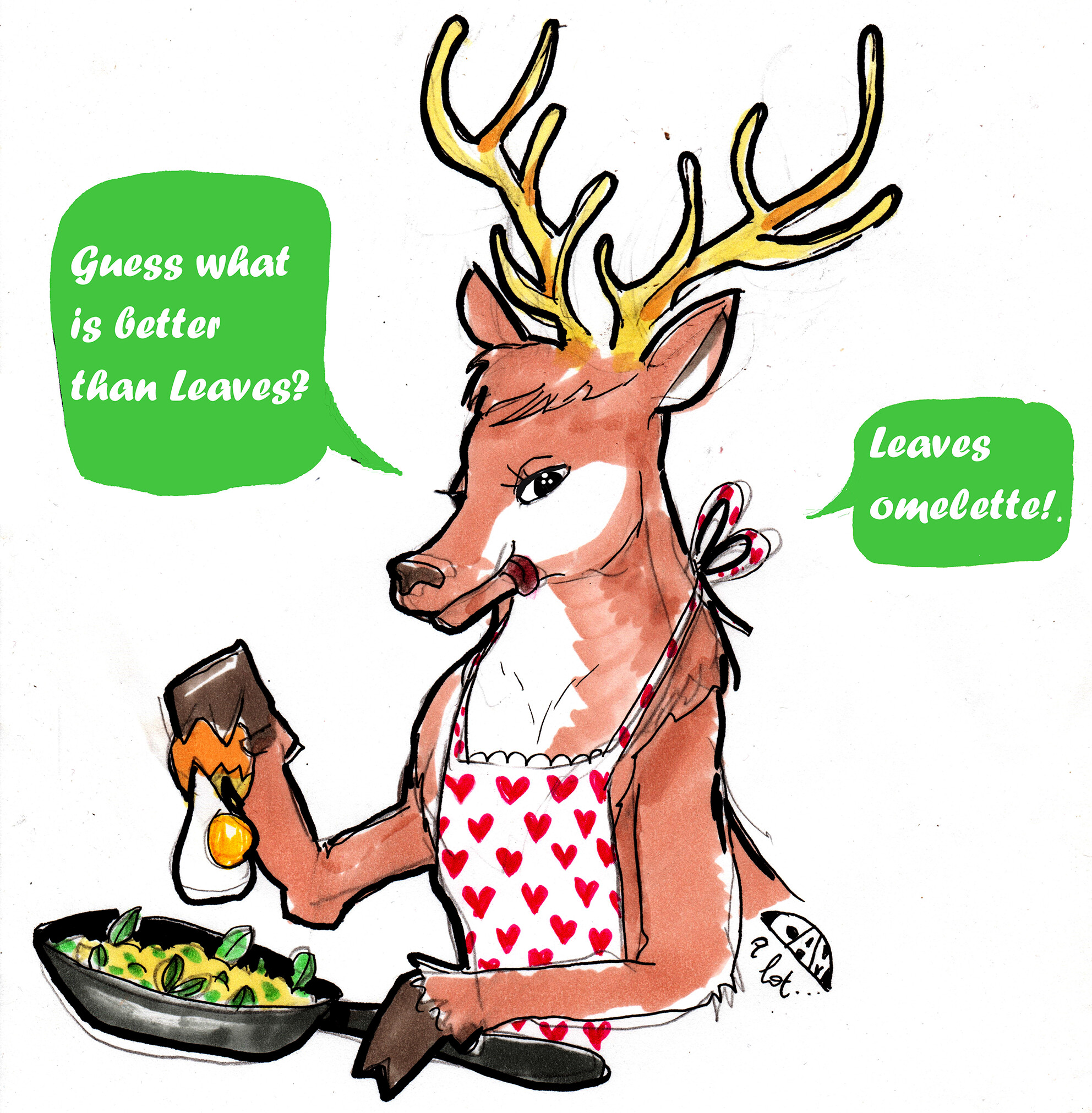
Up to now, deer impacts on birds had been mainly assumed as indirect through mechanisms that negatively influence vegetation complexity reducing habitat quality. Still, information about the direct negative impacts on bird breeding success is scattered and rudimentary at best. Here we document, through videos filmed with camera traps, deer preying on bird nests. Besides, we found evidence of deer nest predation both in native and non-native populations, suggesting a poorly understood deer behavior, which could have profound consequences for bird reproduction and survival.
Mound‐building behaviour of a keystone bioturbator alters rates of leaf litter decomposition and movement in urban reserves
- Austral Ecology
- 1426-1439
- 10.1111/aec.13409
Graphical Abstract
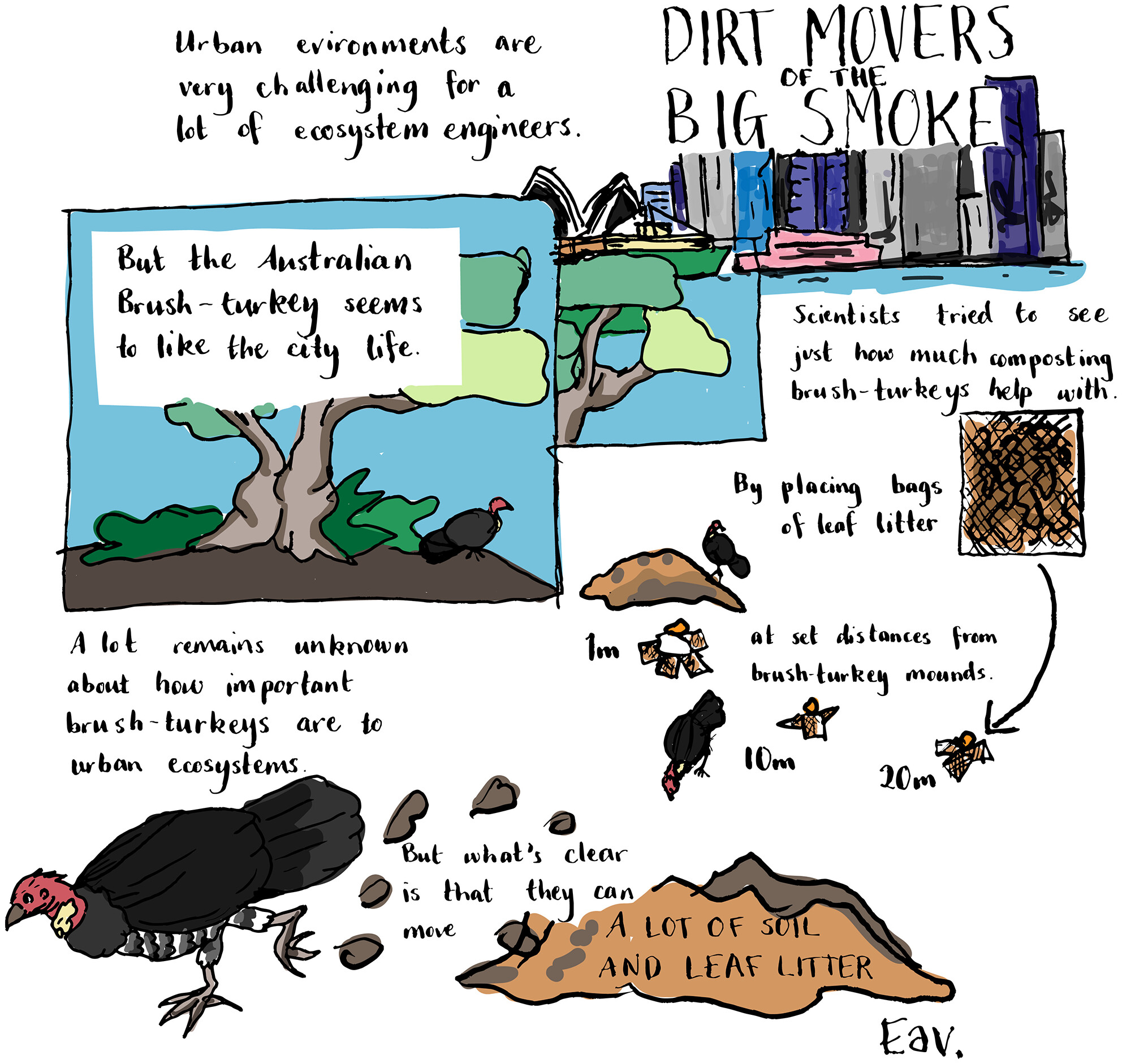
Australian brush-turkeys may act as an ecosystem engineer due to their turnover of soil and leaf litter when building their incubation mounds. We measured leaf litter decomposition rates around brush-turkey mounds in urban reserves using mesh litter bags. Decomposition rates were higher adjacent to mounds during the brush-turkey breeding season.
Turtles in trouble. Conservation ecology and priorities for Australian freshwater turtles
- Austral Ecology
- 1603-1656
- 10.1111/aec.13418
Graphical Abstract
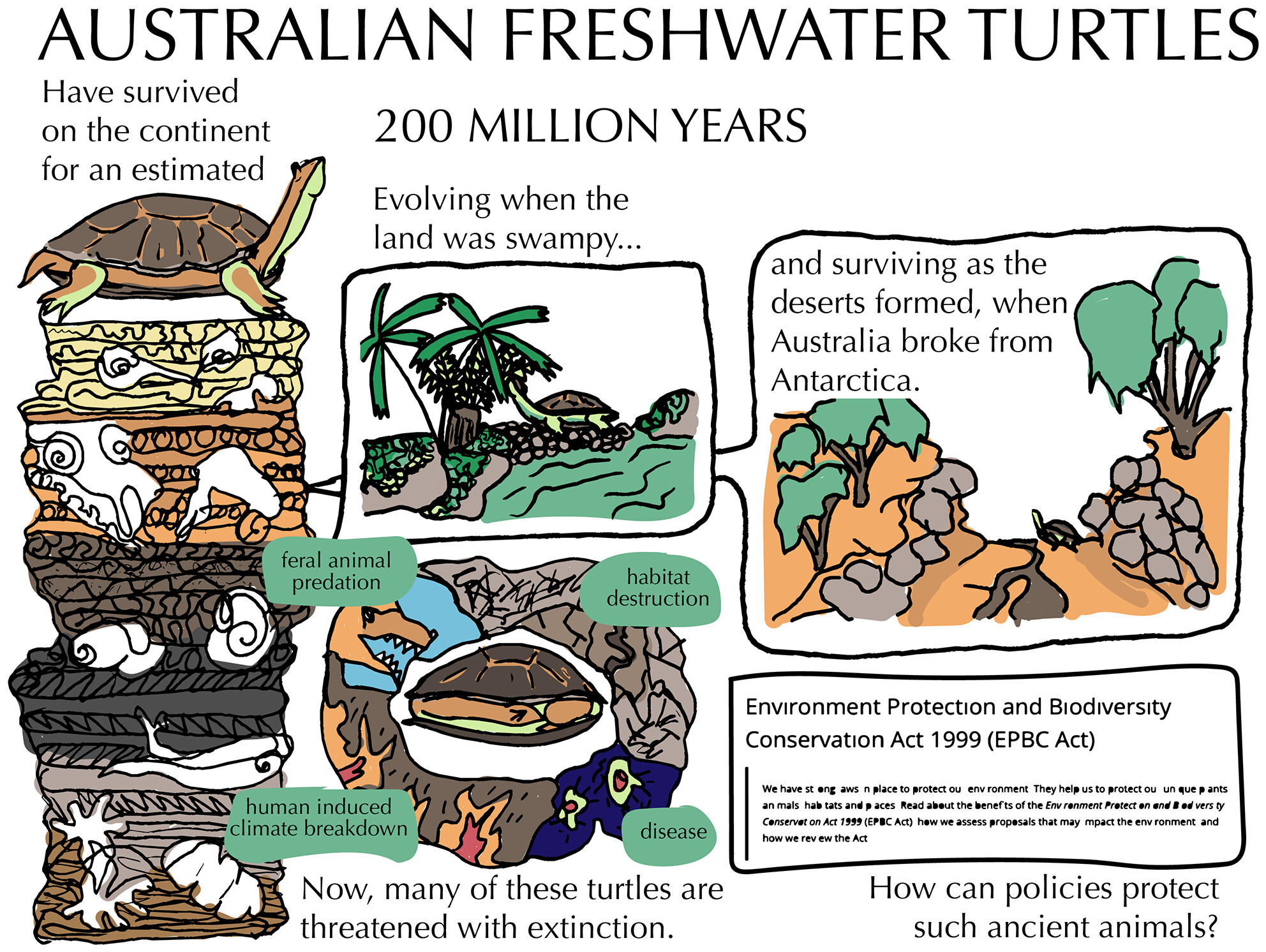
The freshwater turtle fauna in Australia, mainly consisting of species in the family Chelidae, is characterized by distinct lineages that have survived from a more diverse past. Conservation efforts face challenges due to habitat fragmentation, water resource development, invasive predators like foxes and feral pigs, altered land use, and the impact of invasive species and pathogens. This article discusses the process of listing turtles under the Australian Environment Protection and Biodiversity Conservation Act, highlights key threats and knowledge gaps, and explores the inclusion of First Nations Knowledge and the engagement of Indigenous communities in conservation initiatives.
Pollination of Richea dracophylla (Ericaceae) and the role of the nocturnal ant Notoncus hickmani (Formicinae)
- Austral Ecology
- 1762-1778
- 10.1111/aec.13421
Records of the land planarian Polycladus gayi (Tricladida, Geoplanidae) preying on black snails Macrocyclis peruvianus (Gastropoda, Macrocyclidae)
- Austral Ecology
- 2239-2245
- 10.1111/aec.13430




